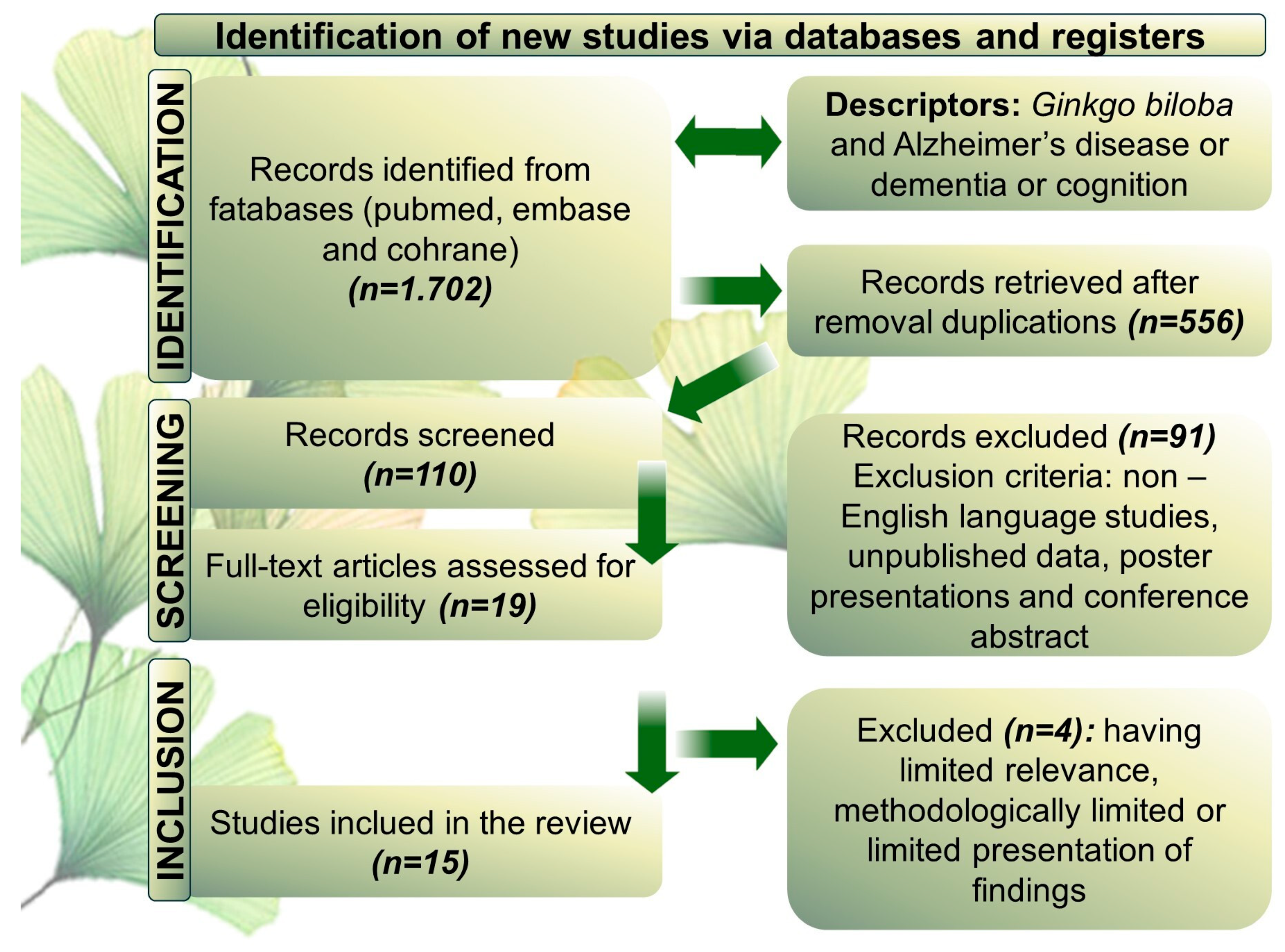Preprint
Review
Ginkgo biloba: A Leaf of Hope in the Fight Against Alzheimer’s Dementia: Clinical Trial Systematic Review
This version is not peer-reviewed.
Submitted:
12 April 2024
Posted:
12 April 2024
You are already at the latest version
A peer-reviewed article of this preprint also exists.
Abstract
Alzheimer's disease (AD) is a stealthy and progressive neurological disorder that is a leading cause of dementia in the global elderly population, imposing a significant burden on both the elderly and society. Currently, the condition is treated with medications that alleviate symptoms. Nonetheless, these drugs may not consistently produce the desired results and can cause serious side effects. Hence, there is a vigorous pursuit of alternative options to enhance the quality of life for patients. Ginkgo biloba (GB), an herb with historical use in traditional medicine, contains bioactive compounds such as terpenoids (Ginkgolides A, B, and C), polyphenols, organic acids, and flavonoids (quercetin, kaempferol, and isorhamnetin). These compounds are associated with anti-inflammatory, antioxidant, and neuroprotective properties, making them valuable for cognitive health. A systematic search across three databases using specific keywords GB in AD and dementia yielded 1702 documents, leading to the selection of 15 clinical trials for synthesis. In eleven studies, GB extract/EGb 761® was shown to improve cognitive function, neuropsychiatric symptoms, and functional abilities in both dementia types. In four studies, however, there were no significant differences between the GB-treated and placebo groups. Significant improvements were observed in scores obtained from the Mini-Mental State Examination (MMSE), Short Cognitive Performance Test (SKT), and Neuropsychiatric Inventory (NPI). While the majority of synthesized clinical trials show Ginkgo biloba has promising potential in these conditions, more research is needed to determine optimal dosages, effective delivery methods, and appropriate pharmaceutical formulations. Furthermore, a thorough assessment of adverse effects, exploration of long-term use implications, and investigation into potential drug interactions are critical aspects that must be carefully evaluated in future studies.
Keywords:
Subject:
Medicine and Pharmacology - Psychiatry and Mental Health1. Introduction
Alzheimer's disease (AD) was first described in 1906 by the German psychiatrist Aloysius Alzheimer. This disease is an insidious and progressive neurodegenerative disorder that gradually deteriorates memory and cognitive functions [1]. Not only is it the leading cause of dementia in the elderly population worldwide, but it is also a major cause of disability. Typically, it displays the characteristic symptoms of being 75 years old, with around 4% of cases being early and severe, affecting language and visuospatial abilities associated with memory. Indeed, the manifestations and indications of AD extend beyond mere memory impairments, encompassing challenges in executing routine activities, disrupted sleep patterns, and even alterations in personality and mood [2,3,4,5,6,7]. Figure 1 illustrates various indicators and manifestations of AD, as well as lifestyle practices that can aid in the management of the condition.
Macroscopically, there is an irreversible loss of 15 to 35 percent of encephalic mass, with significant damage to the white matter, diffuse cortical atrophy, bilateral and symmetrical, and subsequent cerebral gyri narrowing and sulci enlargement affecting primarily the hippocampus. These abnormalities occur due to the accumulation of β-amyloid protein toxic plaques in the nervous tissue's extracellular matrix, hyperphosphorylated tau protein in neurofibrillary tangles, and apolipoprotein E, which is the main risk factor for the development of AD. These changes impair the number of neurons, dendritic branching, and synapse zones [3,8,9,10].
The aggregation of β-amyloid protein is considered to initiate all biochemical alterations in AD. It is a byproduct of the division (split) of amyloid precursor protein (APP), a membrane protein present in neurons. This reaction is catalyzed by three enzymes: alpha-secretase, beta-secretase, and gamma-secretase, each with a specific site of action on APP just above, slightly above, and within the phospholipid bilayer, respectively. The formation of B-amyloid protein toxic plaques is contingent upon the coordination of beta and gamma-secretases within the amyloidogenic pathway. Furthermore, tau protein, a microtubule-associated protein widely distributed inside axons that is responsible for retrograde and anterograde transport of substances, becomes hyperphosphorylated and undergoes a shift associated with the generation of malformed helical filaments, which can then be found inside neurons' soma and dendrites. These neurofibrillary tangles, as they are known, cause the nucleus of the parenchyma to be displaced, thereby preventing communication between parts of the cell and favoring their death and apoptosis [11,12,13,14,15,16] (Figure 2).
Figure 2.
General mechanisms of damage in Alzheimer's Disease (AD). Many factors such as inflammation and free radicals can interfere with enzymes activation and the formation of βA plaques. This scenario leads to increase in inflammatory factors release and installation of oxidative stress leading to neurotoxicity and AD development. ↑ – increase; ↓ –decrease; APP – amyloid precursor protein; βA – β-amyloid.
Figure 2.
General mechanisms of damage in Alzheimer's Disease (AD). Many factors such as inflammation and free radicals can interfere with enzymes activation and the formation of βA plaques. This scenario leads to increase in inflammatory factors release and installation of oxidative stress leading to neurotoxicity and AD development. ↑ – increase; ↓ –decrease; APP – amyloid precursor protein; βA – β-amyloid.
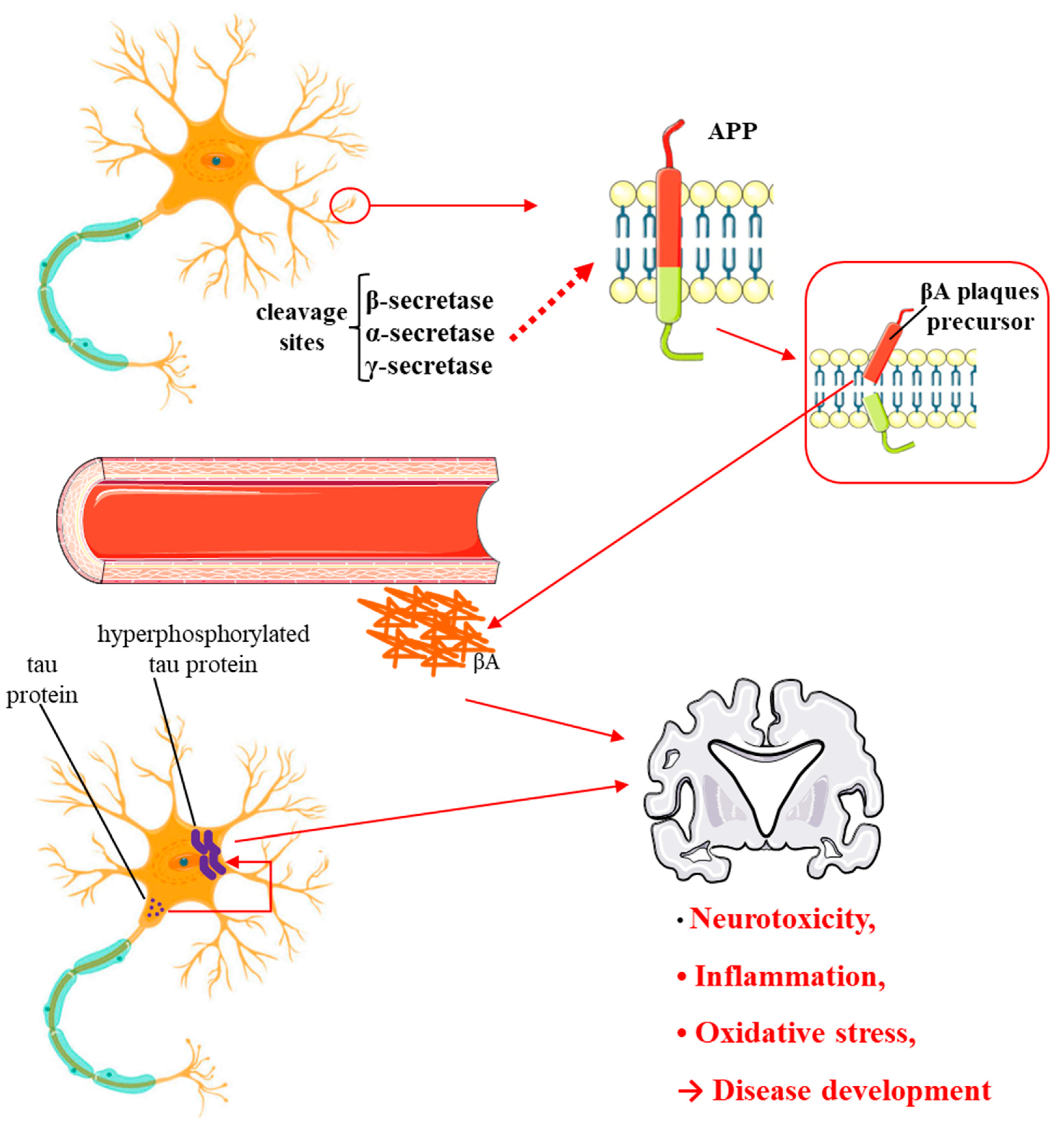
Traditionally, AD has been treated with drugs that relieve symptoms, such as cholinesterase inhibitors (donepezil, rivastigmine, and galantamine) and N-methyl-D-aspartate receptor (NMDAR) antagonists (memantine). In AD, some neurons' acetylcholine secretion is significantly reduced, and NMDAR is greatly stimulated, promoting a deleterious calcium influx sufficient to cause cell death and synaptic dysfunction. Thus, it must be advantageous to prolong the action of the neurotransmitter's remaining molecules attached to cholinergic receptors by preventing recycling and reducing excessive NMDAR activation [17]. Despite this, a cure for AD remains elusive because current pharmacotherapy cannot prevent APP enzymatic cleavage, the first step in the pathogenesis [18]. Hence, alternative treatments may improve patients' quality of life with AD. Novel therapeutic opportunities for AD strategies include improving cognitive function and reducing amyloid deposition, opening up new treatment options, including monoclonal antibodies [6,19,20,21,22,23,24,25].
Herbal medicine's therapeutic strategies are one of the available options for alleviating symptoms [26]. Gingko biloba (GB) is one of the plants whose extracts can be used as an adjuvant in the treatment of AD [27,28]. GB is a gymnosperm from Japan, China, and Korea that belongs to the Ginkgoaceae family and the Ginkgoopsida class of plants. For centuries, it has been used in popular medicine to treat a variety of health problems due to the abundance of bioactive substances such as terpenoids (Ginkgolides A, B, and C), polyphenols, organic acids, and flavonoids (quercetin, kaempferol, and isorhamnetin), which are associated with anti-inflammatory, antioxidant, and antiapoptotic effects (Figure 2) [28,29]. Indeed, the standardized extract of GB (EGB 761) is a popular dietary supplement among the elderly to improve memory and prevent cognitive decline. These effects can be applied to Alzheimer's treatment.
In the Ginkgo Evaluation of Memory Study (GEMS) (a longitudinal analysis), blood amyloid levels and dementia risk were assessed. This study examined the levels of beta-amyloid protein and other substances, such as vitamin B12, liver enzymes, and creatinine, in patients who had their Apolipoprotein E genotyped. For 8.5 years, the authors studied baseline β-amyloid (Aβ) levels in plasma and incident dementia in 2840 individuals aged 75 and up. From this total, 2381 were classified as cognitively normal, while 450 had mild cognitive impairment. The study found that higher plasma levels of Aβ1-40 and Aβ1-42 were associated with age, gender (women), low education, stroke history, hypertension, and creatinine levels. Normal subjects with dementia had lower levels of Aβ1-42 and Aβ1-42/Aβ1-40 compared to those without dementia. Aβ levels did not predict dementia in individuals with mild cognitive impairment, which is noteworthy [30].
This study aims to address the current issues in treating AD and dementia, where the efficacy of GB remains uncertain. Some studies found significant improvements in cognitive function, neuropsychiatric symptoms, and functional abilities, whereas others found no significant difference between the GB-treated and placebo groups. Given these inconsistencies, the study's goal is to provide a comprehensive synthesis of existing clinical data, identify gaps in current research, and guide future studies. Furthermore, we set the objective to explore the potential of GB as an alternative treatment for AD and dementia, particularly considering the limitations and side effects of current AD medications. Through a systematic review and synthesis of clinical trials on the effects of GB extract/EGb 761® on dementia patients, this study examines the effectiveness of GB's bioactive compounds.
2. Methods
This systematic review aimed to investigate the potential benefits of GB for AD or other types of dementia. Only studies published in English were considered, sourced from MEDLINE–PubMed, EMBASE, and Cochrane databases. The search utilized MeSH terms including ‘Ginkgo biloba’ and ‘Alzheimer´s disease’ or ‘dementia,’ or cognition. These terms guided the identification of studies examining GB's effects on AD or dementia. Furthermore, we applied filters to enhance the quality of our search, namely "Clinical Trial" and "Randomized Controlled Trial". Consequently, conferences, abstracts, letters to editors, and other emerging sources were evaluated but not included. Study identification and inclusion were carried out by S.M.B. and M.T., with conflicts resolved by a third author, M.T. Inclusion criteria were limited to human interventional studies, while exclusion criteria comprised studies not in English, reviews, editorials, case reports, poster presentations. and studies with animal models. The search for clinical trials had no temporal restriction. Data extraction followed the PICO (Population, Intervention, Comparison, and Outcomes) format, and study selection adhered to PRISMA (Preferred Reporting Items for Systematic Reviews and Meta-Analyses) guidelines [31,32]. The risk of bias in selected trials was evaluated using the Cochrane Handbook for systematic reviews of interventions [33].
3. Overview of the Included Studies and Result Findings
Initially, 1,702 studies were identified according to the search terms. After applying the inclusion/exclusion criteria, we identified 15 clinical trials involving the use of GB in AD and dementia that met these criteria. Figure 2 shows the selection of the studies in accordance with PRISMA guidelines. Fifteen studies compared the outcomes of GB or GB extract treatment to a placebo. The dosage ranged from 120 to 240 mg, with treatment periods ranging from four to 24 weeks. Four studies found no significant differences between groups treated with GB and placebo. Eleven studies found that administering GB extract/EGb 761® improved cognitive function, neuropsychiatric symptoms, and functional abilities in both types of dementia. Significant differences were found in the Mini-Mental State Examination (MMSE), Short Cognitive Performance Test (SKT), and Neuropsychiatric Inventory (NPI) scores.
4. Discussion
4.1. Ginkgo Biloba, General Aspects
Ginkgo, also known as GB, is a tree that is notable for its distinctive characteristics. The earliest documented records of the Ginkgo tree date back to the 11th century in the Yangtze River region of China. Despite this, it is now grown in a wide range of countries, including New Zealand, Brazil, the Netherlands, Chile, Japan, Belgium, Austria, England, Spain, Italy, Germany, France, Korea, Australia, and India, owing primarily to its ability to thrive in deep and sandy soils found in temperate and subtropical climate regions worldwide. In fact, Ginkgo is known for having a large genome and remarkable tolerance to various stress factors, whether abiotic or biotic; this species demonstrates remarkable resilience and adaptability in the face of adverse conditions, which contributes to its survival and longevity; additionally, it has the ability to cope with various forms of stress, whether caused by the physical environment or interactions with other organisms [49,50,51].
Its leaves, with their distinctive fan-shaped shape and green-yellow color, emit a strong odor. One notable feature of this tree is its impressive height, which ranges between 20 and 30 meters. Ginkgo is also well-known for its incredible longevity, which can last over 1,000 years. The leaves are divided into two distinct lobes, hence the botanical name "biloba". This unique feature makes the tree easily identifiable and distinct in its natural environment. Another interesting aspect is the Ginkgo's reproductive system. This species' trees have distinct male and female flowers, and instead of true seeds, the plant uses an outdated reproductive system that disperses "ovules."[49,52].
The first mention of the internal use of GB leaves for medicinal purposes appears in Wen-Tai's text "Ben Cao Pin Hue Jing Yaor," written in 1505 AD. This work provides information on the traditional uses of GB leaves. Over time, modern Chinese pharmacopeias recognized the therapeutic properties of these leaves, particularly in the treatment of heart and lung disorders [53,54].
GB contains several flavonoids, including quercetin, kaempferol, isorhamnetin, rutin, ginkgetina, and bilobetina. Terpenoids (ginkgolides) include ginkgolide A, ginkgolide B, ginkgolide C, ginkgolide J and ginkgolide M. Terpenoids (bilobalides) include bilobalide A and bilobalide B, as well as proanthocyanidins and organic acids like caffeic acid, ginkgolic acid, and quinic acid. The composition contains phytosterols, including β-sitosterol and stigmasterol. Figure 3 and Table 3 summarize the bio compounds composition of GB. The use of Ginkgo to improve symptoms in patients with oxidative inflammation-related diseases is thought to be associated with improved tissue perfusion and hypoxia tolerance. Ginkgo's flavonoid glycosides exhibit antioxidant and anti-inflammatory properties, which can help reduce endothelial cell damage caused by free radical oxidation [28,55,56,57,58]. Figure 4 shows the major bioactive components found in this plant, parts of the GB tree, and the chemical compounds classified by class and and Table 1 lists the chemical structure of bioactive compounds, parts of the GB tree, and their effects.
Tissue damage activates an inflammatory cascade, a natural response that includes complex molecular reactions and cellular responses. Lysosomal enzymes, such as phospholipase A2 (PLA2), are critical at the start of the cascade because they catalyze the hydrolysis of the sn2 position of membrane glycerophospholipids, resulting in 1-acylphospholipids and free fatty acids such as arachidonic acid. Cyclooxygenase (COX) and lipoxygenase (LOX) degrade arachidonic acid, producing prostaglandins, thromboxanes, leukotrienes, and lipoxins. These substances play a role in vasodilation, platelet aggregation, leukocyte chemotaxis, and monocyte adhesion. When activated excessively or persistently, inflammation can damage organs and systems, resulting in decompensation, organ dysfunction, and death [93,94,95,96].
Genetic links between inflammation-associated factors strengthen the link between inflammation and AD. The amyloid peptides of neuritic plaques and tau protein of neurofibrillary tangles are alterations resulting from post-translational modifications that affect multiple genes, making AD a polygenic neurodegenerative complex disease. β-amyloid accumulation and blood-brain barrier dysfunction contribute to neuroinflammation. Furthermore, neurodegenerative diseases have been linked to neuroinflammation and viral infections, with research indicating that exposure to common viral pathogens increases the risk of conditions such as AD [97,98,99].
The accumulation in the parenchyma and blood vessels induces microglial migration and promotes acute and chronic anti-aggregate inflammatory responses, resulting in the production of nitric oxide, reactive oxygen species (ROS), and proinflammatory cytokines such as Interleukin (IL)-1, IL-6, Tumor Necrosis Factor-α (TNF-α), and prostaglandins (PGE2). This can eventually promote neuronal death (Figure 2) [100,101,102,103,104].
GB has exceptional anti-inflammatory properties due to its unique composition of bioactive compounds. GbE (standardized GB extract) inhibits the secretion of proinflammatory mediators and cytokines, such as nitric oxide, PGE2, TNF-α, IL-6, and IL-1β (Figure 2). Ginkgolide A is the primary compound of GbE that can inhibit cyclooxygenase-2 (COX-2) and 5-lipoxygenase (5-LOX), preventing the production of inflammatory substances [56,105,106,107]. According to studies, GbE treatment significantly altered proteins involved in inflammation (mast cell protease-1, complement C3, T-kininogen 1) and oxidative stress (peroxiredoxin 1) (Figure 4). These proteins are related to the oxidation-reduction process, which is closely linked to inflammation [108,109]. GbE upregulates the expression of lactoylglutathione lyase (glyoxalase I), an enzyme that has anti-inflammatory properties. This enzyme is responsible for neutralizing methylglyoxal, a highly toxic compound produced during glycolysis and lipid peroxidation that can trigger inflammation [58,110].
GB inhibits the activation of nuclear factor kappa B (NF-κB), a transcription factor that activates genes that produce proinflammatory cytokines (Figure 2). This reduces the expression of these cytokines and inflammation mediators. By inhibiting NF-kB, GB also decreases the expression of adhesion molecules, which are proteins found on the surface of cells involved in the immune response and are crucial for guiding immune cells to inflamed areas. There are various types of adhesion molecules, such as intercellular adhesion molecule 1 (ICAM-1) and VCAM-1 (Vascular Cellular Adhesion Molecule 1), that are required for leukocyte adhesion to the surface of blood vessels and subsequent migration to inflammation. By decreasing the expression of these molecules, GB can reduce leukocyte adhesion and migration, resulting in a more controlled and less intense inflammatory response (Figure 2) [111,112,113,114,115,116].
GB has the ability to enhance the generation of nitric oxide by endothelial cells. This is attributed to its active compounds, such as flavonoids, which have the capacity to facilitate vasodilation. As a result, GB causes the relaxation of blood vessel walls, leading to an augmentation in blood flow. Furthermore, this plant also exhibits antiplatelet aggregation properties. These combined factors decrease the likelihood of inflammation caused by damage to the endothelium and the development of atherosclerotic plaques, thus safeguarding multiple systems in the human body. It is important to note that following an injury, GB strengthens blood vessel walls, reducing blood vessel permeability. This inhibits the movement of inflammatory cells into the surrounding tissues [117,118]. Another mechanism proposes that GB may enhance the expression of proteins such as Bcl-xL and Bcl-2. Promoting the production of these proteins increases cell survival because fewer undergo apoptosis, lowering the likelihood of inflammation being triggered (Figure 2). On the other hand, it can inhibit the activity of pro-apoptotic proteins like Bax, effectively blocking the pro-apoptotic signaling pathway [119,120].
4.2. Ginkgo Biloba and Antioxidant Effects
Oxidative stress is a complex pathological process that occurs in the body as a result of aging, infections, psychological stress, and exposure to radiation and chemical agents such as drugs and pollutants over a lifetime. Increased production of ROS and free radicals, which are reactive and attack various cellular components indiscriminately, is one of the damage mechanisms. They can interact with normal structures via electron donation/acceptance, hydrogen removal, addition reactions, self-annihilation, or disproportionation, resulting in irreversible cumulative injury if the endogenous antioxidant system is compromised or there is insufficient intake of exogenous plant-derived antioxidant substances (Figure 2). Therefore, oxidative stress has been linked to the onset of a variety of medical conditions, as well as the worsening of pre-existing pathologies [28,121,122,123,124].
It is important to note that the human body is constantly producing ROS, which are unavoidable byproducts of aerobic metabolism. In aerobic eukaryotic cells, cytochrome oxidase in the electron transport chain reduces more than 90% of oxygen to water via four-electron mechanisms that do not release ROS. The remainder produces superoxide (•O2-) via the hydroperoxyl radical, while mitochondrial respiratory byproducts at 7.4 pH and NADPH oxidase catalyze the synthesis of hydrogen peroxide (H2O2). Superoxide can undergo a transformation into hydrogen peroxide. This hydrogen peroxide can then be converted into different reactive oxygen species (ROS) such as hydroxyl radicals (•OH) and hydroxyl anions (OH-). Finally, catalase facilitates the conversion of these ROS into water [125,126,127,128].
Under normal conditions, various mechanisms exist to combat free radicals. The endogenous antioxidant system consists of uncoupling protein enzymes (superoxide dismutase, glutathione peroxidase, coenzyme Q, and catalase) as well as non-enzymatic molecules that play an important role in the dissipation of free radicals. On the other hand, there is an exogenous antioxidant system that is derived from diet and plant sources such as vitamins A, C, and E, beta-carotene, lycopene, resveratrol, and flavonoids [128,129,130,131,132,133,134,135,136,137].
Regardless of how they work, their anti-aging, anti-cancer, anti-cataract, and antidiabetic properties have been demonstrated, as oxidative stress is largely responsible for disease pathophysiology. GB contains numerous compounds that are beneficial to brain health. Among them, Ginkgolide A stands out for its intriguing effects on cardiovascular and cerebrovascular diseases. Its mechanism of action involves inhibiting a biomarker of oxidative stress, 8-hydroxy-2'-deoxyguanosine (8-OHdG), which is abundant in the brain following inflammation caused by, say, trauma [138]. GB's effects on oxidative stress and neuronal protection are linked to a reduction in ROS formation and action, such as inhibiting NADPH oxidase activation, downregulating the Mitogen-Activated Protein Kinases (MAPK) and activator protein-1 (AP-1) complex, inactivating Signal Transducer and Activator of Transcription 5 (STAT5), and several other molecules (Figure 2) [139,140,141].
Ginkgo biloba (GB) contains bioactive compounds, including flavonoids (approximately 28%) and terpenic lactones (2.8-3.4% of Ginkgolides A, B, and C, and 2.6-3.2% of bilobalide). These compounds have the ability to enhance brain circulation by reducing peroxide levels in cerebellar neurons and protecting cortical neurons from injuries caused by iron. Superoxide dismutase, catalase, and glutathione peroxidase are examples of antioxidant enzymes whose mRNA expression is positively regulated by this plant, which reduces the generation of ROS and free radicals [142,143,144,145]. Ginkgolides A, B, and C can reduce ROS production and levels (Figure 2). For example, ginkgolide A has been shown to reduce malonaldehyde production while increasing glutathione peroxidase and superoxide dismutase expression [146,147,148,149].
Kaempferol can also be found in GB, which is associated with an increase in the expression of brain-derived neurotrophic factor (BDNF), glutamate-cysteine ligase catalytic subunit, B-cell lymphoma protein 2 (BCL-2), and glutathione peroxidases. It can inhibit serotonin degradation, cytochrome C release, caspase-3 activity, and apoptosis (Figure 2). Kaempferol can reduce the neurotoxicity associated with 3-nitropropionic acid [145,150,151]. Quercetin, bilobalide, and isorhamnetin are also found in GB [71]. These phytocounphenols are related to the reduction of inflammatory processes and the production of ROS (Figure 2). Quercetin and bilobalide can work as free radical scavengers. Bilobalide is associated with the stimulation of the expression of cytochrome c oxidase subunit III and BCL-2. Isorhamnetin inhibits DNA fragmentation and apoptosis (Figure 2) [71,152,153,154].
EGB 761® inhibits the formation of hydrogen peroxide radicals, anion superoxide radicals, ROS, reactive nitrogen species, peroxyl radicals, and hydroxyl radicals. Nonetheless, EGB 761® plays a role in increasing the expression of glutathione peroxidase and superoxide dismutase [155,156,157]. Similarly, GB extract (GBE) has a broad pharmacological spectrum for preventing oxidative stress, which protects the central nervous system from depressive processes, improves aspects of impaired neuroplasticity, and increases cellular mitochondrial function (Figure 2). Secondarily, GBE's antioxidant and anti-inflammatory properties improve the prognosis of cardiovascular diseases [158,159,160,161].
4.3. Ginkgo Biloba and Alzheimer's Disease and Dementia: Evidence from Cellular and In Vivo Studies
In vitro, ginkgolide A treatment reduced the expression of pro-inflammatory mediators like COX2 and nitric oxide, as well as cytokines like TNF-α, IL-1, and IL-1β in mouse macrophages and differentiated human monocytes [162]. Furthermore, it has been shown to significantly reduce neurological deficit scores and brain infarct volume in rats suffering from cerebral ischemia/reperfusion damage [163], as well as repair mitochondrial dysfunction in cell culture [164]. Ginkgolide B has been shown to inhibit glutamate-induced apoptosis in astrocytes in vitro when glutamate metabolism is abnormal in the pathological environment of AD (Figure 2) [165]. According to studies, it improves neurological function by promoting the proliferation and differentiation of neural stem cells in rats with cerebral ischemia/reperfusion injury [166]. Electrophysiological recordings from the brain slices of rats exposed to hypoxia in vivo showed increases in the frequency of spontaneous discharge, the frequency of action potentials, and the magnitude of calcium currents. Pre-treatment with ginkgolide B, which may regulate Ca2+ influx in hippocampal neurons, suppressed all of these effects of hypoxia [167]. Figure 4 shows the effects of GB on AD.
In model rats with middle cerebral artery occlusion/reperfusion, ginkgolide C suppresses the CD40/NF-κB pathway to ameliorate cerebral ischemia or reperfusion-induced inflammatory impairments [162]. This compound can inhibit adipogenic factors and enzymes, increase lipolysis in a culture of differentiated adipocytes [168], and exhibit an intriguing anti-neoplastic effect in hepatocellular carcinoma cells [69], suggesting that other tissues may respond better to its application. It has been demonstrated that bilobalide increases neurogenesis and synaptogenesis in the cells of rat fetuses by stimulating the proliferation of hippocampal progenitor cells in a dose-dependent manner [169]. It supports the use of APP processing promoted by alpha-secretase in delaying the onset of AD by reducing the production of beta-amyloid in the human neuroblastoma cell line. Furthermore, studies have shown that bilobalide improves cognitive functions in AD mice [170].
In an in vitro model of AD, resveratrol can reduce oxidative damage to neurons caused by beta-amyloid via the mitophagy pathway [171]. It also had a significant effect on the integrity of the blood-brain barrier in AD-induced rats [172]. This substance was found to have good anticholinergic effects in mice with dementia when combined with other antioxidants such as vitamin E (Figure 2) [173].
In a culture of human umbilical endothelial cells, kaempferol was discovered to bind to vascular endothelial growth factor, improving some angiogenic functions [112]. Kaempferol increased dopaminergic and cholinergic neurotransmission in lab rats' prefrontal cortex, improving cognitive function [174]. It has a synergic effect on the learning and memory capabilities of model rats with AD [175]. Isorhamnetin has been shown to stimulate neurofilament production, which enhances neurite outgrowth and NGF-induced neurofilament expression. In addition,
4.4. Ginkgo Biloba and Neurotransmitters Related to Alzheimer's Disease
4.4.1. Acetylcholine
Several studies indicate that GB may have a direct and indirect impact on cholinergic function [176]. Scopolamine, a muscarinic receptor antagonist, has been shown to cause memory dysfunction in models, supporting this theory. Memory and cognitive function have been demonstrated to be negatively impacted by its administration's transient blockade of cholinergic muscarinic receptors [177]. In rodents, GB treatment reduces scopolamine-induced amnesia, indicating improved cognition. This condition was associated with GB's direct action on cholinergic receptors. This plant appears to directly affect presynaptic cholinergic nerve terminals, inhibiting choline absorption, which is a precursor to acetylcholine synthesis [178]. Other learning and memory models applied to rodents demonstrated the effectiveness of GB in memory acquisition and retention in the face of prolonged treatment [179], as well as an improvement in the animals' memory while using a maze [180]. The study found that using GB in healthy young and elderly humans improved both short-term [181] and long-term [182] memory. In Alzheimer's patients, a 3- to 6-month treatment with 120 to 240 mg of G. biloba extract has a small but significant effect on GB's clinical efficacy [183].
4.4.2. Glutamate and Dopamine
Ginkgolides, biologically active terpene lactones in GB, regulate glutamate transmission in the cortex and hippocampus. The binding of glutamate to receptors activates a short-term modulation pathway that allows ions to enter and exit the cell. The flow of calcium ions triggers the release of glutamate [184]. Ginkgolides influence phospholipase A2 and prevent kinase C activation. In turn, kinase C has a significant effect on calcium circulation by influencing endoplasmic reticulum calcium release. When this pathway is inhibited, calcium flow is blocked, and glutamate cannot be released into the synapse. Thus, ginkgolides' inhibitory function is demonstrated by their ability to reduce glutamate-induced damage in hippocampal neuronal cells in the face of cerebral ischemia [185]. Normal excitatory neurotransmission requires glutamate to be removed from the synapse by its transporters [186]. Failure to withdraw causes toxicity that can cause acute neurodegenerative diseases like epilepsy and hypoxia, as well as chronic neurodegenerative diseases like Alzheimer's and Huntington's Syndrome [187].
Similarly, the presence of ginkgolides appears to modulate the neurotransmitter dopamine, which regulates cognition, voluntary movements, and the activation of the punishment and reward system [188]. Chronic ginkgolide administration increases dopaminergic and noradrenergic transmission in the frontal cortex of the brain [186]. Furthermore, ginkgolides boost dopaminergic activity in rats' paraventricular nuclei [189]. This effect can be explained by the inhibitory effect of ginkgolides on MAO (monoamine oxidase). MAO is responsible for the elimination of norepinephrine at synapses. Yoshaitatake et al. demonstrated that a single oral dose did not affect monoamine concentration levels [186]. Dysregulation of dopamine homeostasis is associated with the pathogenesis of neurodegenerative diseases. For example, growth hormone receptor 1α (GHSR1α)-induced disruption of dopamine D1 receptor (DRD1) function exacerbates the pathophysiology of AD [190].
4.4.3. Serotonin - 5HT
Changes in behavior, as in the case of depression, can be identified in individuals with AD [191], suggesting functional changes in the monoaminergic system, and not only in the cholinergic system [192]. Some studies have shown that serotonin receptors, in addition to increasing cholinergic neurotransmission, also improve neurogenesis processes, neuronal plasticity and reduce amyloid load in the brain [193,194].
In relation to serotonin 5-HT1A receptors, a decrease in their expression is observed in the aging phase [195]. However, this condition can be reversed with treatment with GB [196]. Although the mechanisms of action of GB in neuroprotective events are not well understood, the modulation of serotonin levels was observed, as well as the increase in dopamine levels due to the reduction of mannoamine oxidase (MAO) activity in the prefrontal cortex in the presence of this substance [197,198,199,200].
In rats that received GB treatment for 3 weeks with an average consumption of 50-300 mg of GB, a slight increase in serotonin levels was observed in brain regions such as the prefrontal cortex and hippocampus [201].
4.5. Ginkgo Biloba and miAlzheimer’s Disease and Dementia: The Results of Clinical Trials
Patients treated with MEMO (a combination of 750 mg of lyophilized royal jelly and 120 mg of standardized extracts of GB) had higher MMSE (Mini-Mental State Examination) scores than the control group (+2,07 and +0,13, respectively). The trial was randomized, double-blind, and placebo-controlled, which was a plus; however, the follow-up period was brief [34]. The protective effect of GB extract on the incidence of Alzheimer's disease was not supported by conclusive research. The study's sample size included over 2,500 randomly assigned patients who were evaluated on a five-year cycle. Despite this, the trial failed to demonstrate a protective effect because the number of dementia events was significantly lower than expected, resulting in a lack of statistical power to detect effects. Furthermore, more than 700 patients dropped out, which was a negative point [35].
The efficacy of GB was evaluated, as well as his tolerability in AD. The GB-treated group's MMSE scores increased from 16.52+-4.124 to 16.76+-4.116, with no significant difference (p>0.05) [34]. GB enhanced cognitive functioning, neuropsychiatric symptoms, and functional abilities in dementia patients. The SKT total score (drug-placebo differences: 1.7 for AD, p<0.001, and 1.4 for VaD, p<0.05) and the NPI total score (drug-placebo differences: 3.1 for AD, p<0.001, and 3.2 for VaD, p<0.05) demonstrate a significant drug-placebo difference. The results could not be properly interpreted due to the high prevalence of mixed pathologies and the challenges associated with accurate diagnostic classification. Nevertheless, the sample selected was representative of the patients with dementia encountered in daily practice and was appropriately allocated to each type of dementia diagnosed [39].
A once-daily dosage of EGb 761 significantly improves patients' neuropsychiatric symptoms and cognitive function, making it an effective treatment for dementia. On the SKT total score, patients' improvements ranged from 2.2 to 3.5 points. There was adequate follow-up and randomization; however, the patients' low average age and enrollment as outpatients may have limited the generalizability of the results [202].
Patients who received GB extract improved by -1.4 points on the SKT and -3.2 points on the NPI total score, whereas those who received placebo deteriorated by +0.3 on the SKT and did not change on the NPI total score. Ginkgo outperformed placebo on all secondary outcome measures. Positive aspects of the study include the requirement for a computer tomography or magnetic resonance imaging that is no more than one year old to confirm the inclusion diagnosis and to show no evidence of other brain lesions that could account for the cognitive deficit, which increases the research's reliability, as well as small and balanced losses between the groups at the end of the trial. The fact that there are more women than men included in the study could be a source of bias. According to the authors, a once-daily Ginkgo dosing regimen is both safe and effective for dementia [203]. One newly developed GB leaf extract is a safe, effective, and, at the very least, adjuvant treatment option for patients with mild cognitive impairment, improving symptoms of forgetfulness, impaired concentration, and impaired memory. The short duration of treatment may be a bias in this study, and the use of medications may result in an improvement in mental capacity during the study [40].
The combined treatment of GB plus donepezil was found to be consistently and slightly more effective than administering these medications separately. Positive aspects of the study include the recruitment of patients from a large proportion of disabled Alzheimer's patients with behavioral and psychological symptoms, as well as the requirement of computer tomography or magnetic resonance imaging to confirm the diagnosis of probable AD. The study's limitations include a small sample size [41].
Ginkgo is ineffective in preventing or delaying the onset of all-cause dementia in participants older than 75 years of age. This was demonstrated in the largest clinical trial to date evaluating the impact of GB on the incidence of dementia, involving over three thousand patients. The study's strengths include the large number of patients under investigation and the balanced proportion of men and women (46% at baseline). Furthermore, the researchers included measures of overall cognitive decline and disability as secondary outcomes of the study but did not provide data in the paper, which could help us understand whether Ginkgo has a short-term effect on memory [42]. More evidence on the efficacy and safety of Ginkgo in treating cognitive and non-cognitive symptoms of dementia has been added. The treatment group improved by -3.2 points on the SKT, while the placebo group deteriorated by +1.3 points on the same test. One of the study's major strengths was that the patients were recruited outside of the norm of daily practice, with less stringent eligibility criteria than are typically used in other dementia studies. The study's drawback is that the small age average of 64 years may account for the patients' high responsiveness to drug treatment, as well as the absence of death and, thus, the low rate of premature discontinuation, both of which situations may distort the analysis's results [43].
The outcomes of patients who received daily doses of GB extract, donepezil, or a placebo were compared. The study found statistical differences in MMSE and SKT scores between the groups, demonstrating GB's effectiveness. There were no differences between the donepezil and EGb groups in this study. The study's limitation was the small number of participants, which was insufficient for the baseline assessment [44]. Some studies on the use of GB extract in mild to moderate Alzheimer's dementia proved inconclusive. There were no significant differences found among the groups in the entire sample. Nonetheless, patients who received the placebo experienced a minor decline in cognitive and functional aspects [204]. One study found no statistically significant differences in mean score changes between the Ginkgo-treated and placebo groups. There were minimal or no differences between the groups, and none of the main outcome measures were statistically significant (SKT:0.4; CGI-2:0.0; NAI-NAA:0.0). The ineffective multi-purpose design, unequal treatment distribution, and inconsistent findings with other studies are the main weaknesses of the study. The significant number of participants who left the study early is another disadvantage [48].
After EGb 761 was administered for six months, the patients in that group exhibited a small improvement. The findings from both the ITT and evaluable data show that EGb is effective in two assessment domains, specifically cognitive performance (ADAS-Cog). In terms of ADAS-Cog scores, the placebo group experienced a significant decline from their initial baseline score, whereas the EGb group showed a trend of improvement. One of the strengths of this study is its duration, which contributes to the study's reasonable efficacy. The study suggests that more research is needed to determine the role of GB in dementia treatment and its potential as an alternative or adjunct to cholinesterase inhibitors [47].
One study found that Ginkgo had no effect on each of the main outcome measures for participants compared to a placebo over the course of the 24-week treatment period. Furthermore, no benefits from higher doses or longer periods of Ginkgo treatment were discovered. The trial results indicate that this plant is ineffective for treating older people with age-related memory impairment or mild to moderate dementia. The study's strengths include a rigorous comparison, a comprehensive review of the existing literature, and methodological consistency. Nevertheless, the primary limitation of the study lies in its failure to establish the effectiveness of GB in enhancing cognitive and functional outcomes, thereby contradicting the prevailing body of research in this domain [48].
5. Conclusion
This systematic review of clinical trials on the efficacy of GB in AD and cognitive impairment provides a nuanced perspective. While some studies showed improvements in cognitive functioning and neuropsychiatric symptoms after GB treatment, others found no significant differences when compared to placebo or donepezil. Notably, the combination of GB and donepezil provided marginal benefits, especially in patients with AD behavioral symptoms. However, large-scale trials revealed that GB did not effectively prevent or delay dementia onset in older people. The limitations of these studies, such as small sample sizes, inconsistent findings, and diagnostic challenges, had a significant impact on the interpretation of results. Furthermore, some trials did not establish a protective effect of GB extract against AD. In light of these conflicting findings, more research with robust methodologies and larger sample sizes is needed to elucidate the role of GB extract in AD and cognitive impairment. Future investigations should explore optimal dosages, long-term effects, and potential synergies with existing treatments to enhance our understanding of GB's therapeutic potential in dementia management.
Author Contributions
Conceptualization, S.M.B.; methodology, M.T., G.L.O.P, L.M.O.S., N.O., E.P.L., and R.A.G.; investigation, G.L.O.P, L.M.O.S., N.O., C.B.L., R.C.M.S., and L.F.L.; writing—original draft preparation, M.T., L.F.L., and S.M.B.; writing—review and editing, M.T.; G.L.O.P, L.M.O.S., N.O., E.P.L., and S.M.B.; visualization, R.D., L.M.G and C.B.L.; supervision, M.T. and S.M.B. and M.T..; project administration, M.T. and S.M.B. All authors agreed to the final version of this manuscript.
Funding
This research received no external funding.
Institutional Review Board Statement
Not applicable.
Informed Consent Statement
Not applicable.
Data Availability Statement
Not applicable.
Acknowledgments
The authors attributes to Smart Servier (https://smart.servier.com/, accessed on 26 January 2024) the scientific images that were used in this article under an attribution license of public copyrights (https://creativecommons.org/licenses/by/3.0/, accessed on 26 January 2024) and under disclaimer of warranties. All Smart Servier’s images were not changed in the writing of this article.
Conflicts of Interest
The authors declare no conflicts of interest.
Abbreviations
Aβ42, amyloid-β42; ACTH, corticotrophic hormone; ADAS-Cog, Alzheimer’s disease assessment scale-cognitive subscale; ADHD, attention-deficit hyperactivity disorder; AMPA, α-amino-3-hydroxy-5-methyl-4-isoxazolepropionic acid; AQP, aquaporin; ASD, autism spectrum disorder; AVLT, Rey Auditory Verbal Learning Test; BACE, beta-site amyloid precursor protein cleaving enzyme; Bax, Bcl-2-associated X protein; Bcl, B-cell lymphoma; BDNF, Brain-derived neurotrophic factor; BM, Bacopa monnieri L.; BME, Bacopa monnieri ethanolic extract; CAT, catalase; CCR, C-C chemokine receptor; ChAT, Choline Acetyltransferase; CNS, Central Nervous System; COX, cyclooxygenase; CREB, Cyclic AMP response element-binding protein; DAMP, damage-associated molecular patterns; DCX, Doublecortin neuronal marker; DM2, type 2 diabetes mellitus; DSM-IV, Diagnostic and Statistical Manual of Mental Disorders; ERK, extra-cellular signal-regulated kinase; FADD, FAZ-associated death domain protein; GCLC, glutamate cysteine ligase catalytic subunit; GDS, geriatric depression scale; GPx, Glutathione peroxidase; GSH, Glutathione; GSK-3B, glycogen synthase kinase; GST, glutathione S-transferase; GWI, Gulf War Illness; HO, heme oxygenase; ICF, chronic liver failure; IKK, The inhibitor of nuclear factor-κB kinase; IL, Interleukin; INF- γ, Interferon-γ; iNOS, inducible Nitric Oxide synthase; JNK, c-Jun N-terminal kinases; LOX, Lipoxygenase; LPS, lipopolysaccharide; MAO, mono-amino oxidase; MARK, Microtubule affinity regulating kinase; MCP, Monocyte chemoattractant protein; MDA, Malonaldehyde; MMP, Matrix Metalloproteinase; MMSE, Mini-Mental State Examination; MoCA, Montreal Cognitive Assessment; MPTP, 1-methyl-4-phenyl-1,2,3,6 tetrahydropyridine; MTF, multitasking framework; NF-κB, Nuclear Factor-κB; NMDAR, N-methyl-D-aspartate receptors; nNOS, neuronal nitric oxide synthase; NO, Nitric Oxide; 3-NPA, 3-nitropropionic acid; Nrf2, Nuclear factor erythroid 2-related factor 2; OGD, oxygen and glucose-deprivation; OS, oxidative stress; PGES, Prostaglandin; PGIMS, postgraduate institute memory scale; PGQL, Parkinson’s Disease Quality-of-Life; PPI, protein-protein interactions; PSQ, Perceived Stress Questionnaire; PTUPB, dual inhibitor of COX and epoxide hydrolase; RNS, reactive nitrogen species; ROS, reactive oxygen species; SDAT, Senile Dementia of Alzheimer’s Type; SDQ, strength and difficulties questionnaire; SHAPS, Snaith–Hamilton Pleasure Scale; sHE, soluble Epoxide Hydrolase; SOD, Superoxide Dismutase; STAT, signal transducers and activators of transcription; TAA, thioacetamide; TNF-α, Tumor necrosis factor alpha; TRADD, TNFR1-associated death domain protein; WS, Withania somnifera (L.) Dunal.
References
- Alzheimer, A. Uber eigenartige Erkrankung der Hirnrinde. All Z Psychiatr 1907, 64, 146–148. [Google Scholar]
- Scheyer, O.; Rahman, A.; Hristov, H.; Berkowitz, C.; Isaacson, R.S.; Diaz Brinton, R.; Mosconi, L. Female Sex and Alzheimer's Risk: The Menopause Connection. J Prev Alzheimers Dis 2018, 5, 225–230. [Google Scholar] [CrossRef] [PubMed]
- Raz, L.; Knoefel, J.; Bhaskar, K. The neuropathology and cerebrovascular mechanisms of dementia. J Cereb Blood Flow Metab 2016, 36, 172–186. [Google Scholar] [CrossRef]
- Bondi, M.W.; Edmonds, E.C.; Salmon, D.P. Alzheimer's Disease: Past, Present, and Future. J Int Neuropsychol Soc 2017, 23, 818–831. [Google Scholar] [CrossRef] [PubMed]
- Battaglia, S.; Avenanti, A.; Vécsei, L.; Tanaka, M. Neural Correlates and Molecular Mechanisms of Memory and Learning. International journal of molecular sciences 2024, 25. [Google Scholar] [CrossRef] [PubMed]
- Tanaka, M.; Szabó, Á.; Körtési, T.; Szok, D.; Tajti, J.; Vécsei, L. From CGRP to PACAP, VIP, and Beyond: Unraveling the Next Chapters in Migraine Treatment. Cells 2023, 12. [Google Scholar] [CrossRef]
- Tanaka, M.; Chen, C. Editorial: Towards a mechanistic understanding of depression, anxiety, and their comorbidity: perspectives from cognitive neuroscience. Frontiers in behavioral neuroscience 2023, 17, 1268156. [Google Scholar] [CrossRef] [PubMed]
- Lei, P.; Ayton, S.; Bush, A.I. The essential elements of Alzheimer's disease. J Biol Chem 2021, 296, 100105. [Google Scholar] [CrossRef]
- Balestrieri, J.V.L.; Nonato, M.B.; Gheler, L.; Prandini, M.N. Structural Volume of Hippocampus and Alzheimer's Disease. Rev Assoc Med Bras (1992) 2020, 66, 512–515. [Google Scholar] [CrossRef]
- Makowski, L. The Structural Basis of Amyloid Strains in Alzheimer's Disease. ACS Biomater Sci Eng 2020, 6, 2498–2505. [Google Scholar] [CrossRef]
- Ashrafian, H.; Zadeh, E.H.; Khan, R.H. Review on Alzheimer's disease: Inhibition of amyloid beta and tau tangle formation. Int J Biol Macromol 2021, 167, 382–394. [Google Scholar] [CrossRef] [PubMed]
- Fukumori, A.; Feilen, L.P.; Steiner, H. Substrate recruitment by γ-secretase. Semin Cell Dev Biol 2020, 105, 54–63. [Google Scholar] [CrossRef] [PubMed]
- Hur, J.Y. γ-Secretase in Alzheimer's disease. Exp Mol Med 2022, 54, 433–446. [Google Scholar] [CrossRef] [PubMed]
- Wang, S.; Mustafa, M.; Yuede, C.M.; Salazar, S.V.; Kong, P.; Long, H.; Ward, M.; Siddiqui, O.; Paul, R.; Gilfillan, S.; et al. Anti-human TREM2 induces microglia proliferation and reduces pathology in an Alzheimer's disease model. J Exp Med 2020, 217. [Google Scholar] [CrossRef]
- Sinsky, J.; Pichlerova, K.; Hanes, J. Tau Protein Interaction Partners and Their Roles in Alzheimer's Disease and Other Tauopathies. Int J Mol Sci 2021, 22. [Google Scholar] [CrossRef] [PubMed]
- Lane, C.A.; Hardy, J.; Schott, J.M. Alzheimer's disease. Eur J Neurol 2018, 25, 59–70. [Google Scholar] [CrossRef] [PubMed]
- Breijyeh, Z.; Karaman, R. Comprehensive Review on Alzheimer's Disease: Causes and Treatment. Molecules 2020, 25. [Google Scholar] [CrossRef] [PubMed]
- Van Bulck, M.; Sierra-Magro, A.; Alarcon-Gil, J.; Perez-Castillo, A.; Morales-Garcia, J.A. Novel Approaches for the Treatment of Alzheimer's and Parkinson's Disease. Int J Mol Sci 2019, 20. [Google Scholar] [CrossRef] [PubMed]
- Martos, D.; Lőrinczi, B.; Szatmári, I.; Vécsei, L.; Tanaka, M. The Impact of C-3 Side Chain Modifications on Kynurenic Acid: A Behavioral Analysis of Its Analogs in the Motor Domain. International journal of molecular sciences 2024, 25. [Google Scholar] [CrossRef]
- Battaglia, S.; Schmidt, A.; Hassel, S.; Tanaka, M. Editorial: Case reports in neuroimaging and stimulation. Frontiers in psychiatry 2023, 14, 1264669. [Google Scholar] [CrossRef]
- Martos, D.; Tuka, B.; Tanaka, M.; Vécsei, L.; Telegdy, G. Memory Enhancement with Kynurenic Acid and Its Mechanisms in Neurotransmission. Biomedicines 2022, 10. [Google Scholar] [CrossRef] [PubMed]
- Battaglia, S.; Di Fazio, C.; Mazzà, M.; Tamietto, M.; Avenanti, A. Targeting Human Glucocorticoid Receptors in Fear Learning: A Multiscale Integrated Approach to Study Functional Connectivity. International journal of molecular sciences 2024, 25. [Google Scholar] [CrossRef]
- Di Gregorio, F.; Battaglia, S. Advances in EEG-based functional connectivity approaches to the study of the central nervous system in health and disease. Advances in clinical and experimental medicine : official organ Wroclaw Medical University 2023, 32, 607–612. [Google Scholar] [CrossRef]
- Battaglia, S.; Avenanti, A.; Vécsei, L.; Tanaka, M. Neurodegeneration in Cognitive Impairment and Mood Disorders for Experimental, Clinical and Translational Neuropsychiatry. Biomedicines 2024, 12. [Google Scholar] [CrossRef]
- Cummings, J. Anti-Amyloid Monoclonal Antibodies are Transformative Treatments that Redefine Alzheimer's Disease Therapeutics. Drugs 2023, 83, 569–576. [Google Scholar] [CrossRef] [PubMed]
- Valotto Neto, L.J.; Reverete de Araujo, M.; Moretti Junior, R.C.; Mendes Machado, N.; Joshi, R.K.; dos Santos Buglio, D.; Barbalho Lamas, C.; Direito, R.; Fornari Laurindo, L.; Tanaka, M.J.A. Investigating the Neuroprotective and Cognitive-Enhancing Effects of Bacopa monnieri: A Systematic Review Focused on Inflammation, Oxidative Stress, Mitochondrial Dysfunction, and Apoptosis. 2024, 13, 393.
- Singh, S.K.; Srivastav, S.; Castellani, R.J.; Plascencia-Villa, G.; Perry, G. Neuroprotective and Antioxidant Effect of Ginkgo biloba Extract Against AD and Other Neurological Disorders. Neurotherapeutics 2019, 16, 666–674. [Google Scholar] [CrossRef]
- Barbalho, S.M.; Direito, R.; Laurindo, L.F.; Marton, L.T.; Guiguer, E.L.; Goulart, R.A.; Tofano, R.J.; Carvalho, A.C.A.; Flato, U.A.P.; Capelluppi Tofano, V.A.; et al. Ginkgo biloba in the Aging Process: A Narrative Review. Antioxidants (Basel) 2022, 11. [Google Scholar] [CrossRef]
- Aminifard, T.; Razavi, B.M.; Hosseinzadeh, H. The effects of ginseng on the metabolic syndrome: An updated review. Food Sci Nutr 2021, 9, 5293–5311. [Google Scholar] [CrossRef]
- Lopez, O.L.; Chang, Y.; Ives, D.G.; Snitz, B.E.; Fitzpatrick, A.L.; Carlson, M.C.; Rapp, S.R.; Williamson, J.D.; Tracy, R.P.; DeKosky, S.T.; Kuller, L.H. Blood amyloid levels and risk of dementia in the Ginkgo Evaluation of Memory Study (GEMS): A longitudinal analysis. Alzheimer's & dementia : the journal of the Alzheimer's Association 2019, 15, 1029–1038. [Google Scholar] [CrossRef]
- Page, M.J.; McKenzie, J.E.; Bossuyt, P.M.; Boutron, I.; Hoffmann, T.C.; Mulrow, C.D.; Shamseer, L.; Tetzlaff, J.M.; Akl, E.A.; Brennan, S.E.; et al. The PRISMA 2020 statement: an updated guideline for reporting systematic reviews. BMJ (Clinical research ed.) 2021, 372, n71. [Google Scholar] [CrossRef]
- Moher, D.J.A.I.M. Liberat i A, Tetzlaff J, et al. Preferred reporting items for systematic reviews and meta-analyses: the PRISMA statement. 2009, 151, 264–269. [Google Scholar]
- Cumpston, M.; Li, T.; Page, M.J.; Chandler, J.; Welch, V.A.; Higgins, J.P.; Thomas, J.J.T.C.d.o.s.r. Updated guidance for trusted systematic reviews: a new edition of the Cochrane Handbook for Systematic Reviews of Interventions. 2019, 2019. 2019.
- Yakoot, M.; Salem, A.; Helmy, S. Effect of Memo®, a natural formula combination, on Mini-Mental State Examination scores in patients with mild cognitive impairment. Clin Interv Aging 2013, 8, 975–981. [Google Scholar] [CrossRef] [PubMed]
- Vellas, B.; Coley, N.; Ousset, P.-J.; Berrut, G.; Dartigues, J.-F.; Dubois, B.; Grandjean, H.; Pasquier, F.; Piette, F.; Robert, P. Long-term use of standardised Ginkgo biloba extract for the prevention of Alzheimer's disease (GuidAge): a randomised placebo-controlled trial. The Lancet Neurology 2012, 11, 851–859. [Google Scholar] [CrossRef] [PubMed]
- NM, N.; MA, B.; MR, N.; F, R.; SN, N. Efficacy of rivastigmine in comparison to ginkgo for treating Alzheimer's dementia. JPMA. The Journal of the Pakistan Medical Association 2012, 62. [Google Scholar]
- R, I.; M, T.; N, B. Efficacy and tolerability of a once daily formulation of Ginkgo biloba extract EGb 761® in Alzheimer's disease and vascular dementia: results from a randomised controlled trial. Pharmacopsychiatry 2012, 45. [Google Scholar] [CrossRef]
- H, H.; A, N.; S, L.; I, S.; R, H.; S, S. Ginkgo biloba extract EGb 761® in dementia with neuropsychiatric features: a randomised, placebo-controlled trial to confirm the efficacy and safety of a daily dose of 240 mg. Journal of psychiatric research 2012, 46. [Google Scholar] [CrossRef]
- Ihl, R.; Bachinskaya, N.; Korczyn, A.D.; Vakhapova, V.; Tribanek, M.; Hoerr, R.; Napryeyenko, O.; Group, G.S. Efficacy and safety of a once-daily formulation of Ginkgo biloba extract EGb 761 in dementia with neuropsychiatric features: a randomized controlled trial. International journal of geriatric psychiatry 2011, 26, 1186–1194. [Google Scholar] [CrossRef] [PubMed]
- Bäurle, P.; Suter, A.; Wormstall, H. Safety and effectiveness of a traditional ginkgo fresh plant extract - results from a clinical trial. Forsch Komplementmed 2009, 16, 156–161. [Google Scholar] [CrossRef]
- Yancheva, S.; Ihl, R.; Nikolova, G.; Panayotov, P.; Schlaefke, S.; Hoerr, R. Ginkgo biloba extract EGb 761(R), donepezil or both combined in the treatment of Alzheimer's disease with neuropsychiatric features: a randomised, double-blind, exploratory trial. Aging Ment Health 2009, 13, 183–190. [Google Scholar] [CrossRef]
- DeKosky, S.T.; Williamson, J.D.; Fitzpatrick, A.L.; Kronmal, R.A.; Ives, D.G.; Saxton, J.A.; Lopez, O.L.; Burke, G.; Carlson, M.C.; Fried, L.P.; et al. Ginkgo biloba for prevention of dementia: a randomized controlled trial. Jama 2008, 300, 2253–2262. [Google Scholar] [CrossRef]
- Napryeyenko, O.; Borzenko, I. Ginkgo biloba special extract in dementia with neuropsychiatric features. A randomised, placebo-controlled, double-blind clinical trial. Arzneimittelforschung 2007, 57, 4–11. [Google Scholar] [CrossRef]
- Mazza, M.; Capuano, A.; Bria, P.; Mazza, S. Ginkgo biloba and donepezil: a comparison in the treatment of Alzheimer's dementia in a randomized placebo-controlled double-blind study. Eur J Neurol 2006, 13, 981–985. [Google Scholar] [CrossRef] [PubMed]
- QX, Z.; T, S.; DY, T.; R, D.; ZZ, L.; XJ, Z. Protective effects of Ginkgo biloba leaf extracts on trichloroethylene-induced human keratinocyte cytotoxicity and apoptosis. Skin pharmacology and physiology 2005, 18. [Google Scholar] [CrossRef]
- M, v.D.; E, v.R.; A, K.; H, S.; P, K. Ginkgo for elderly people with dementia and age-associated memory impairment: a randomized clinical trial. Journal of clinical epidemiology 2003, 56. [Google Scholar] [CrossRef]
- Le Bars, P.L.; Kieser, M.; Itil, K.Z. A 26-week analysis of a double-blind, placebo-controlled trial of the ginkgo biloba extract EGb 761 in dementia. Dement Geriatr Cogn Disord 2000, 11, 230–237. [Google Scholar] [CrossRef] [PubMed]
- van Dongen, M.C.; van Rossum, E.; Kessels, A.G.; Sielhorst, H.J.; Knipschild, P.G. The efficacy of ginkgo for elderly people with dementia and age-associated memory impairment: new results of a randomized clinical trial. J Am Geriatr Soc 2000, 48, 1183–1194. [Google Scholar] [CrossRef] [PubMed]
- Zheng, H.; Wang, B.; Hua, X.; Gao, R.; Wang, Y.; Zhang, Z.; Zhang, Y.; Mei, J.; Huang, Y.; Huang, Y.; et al. A near-complete genome assembly of the allotetrapolyploid Cenchrus fungigraminus (JUJUNCAO) provides insights into its evolution and C4 photosynthesis. Plant Commun 2023, 4, 100633. [Google Scholar] [CrossRef] [PubMed]
- Singh, B.; Kaur, P.; Singh, R.; Ahuja, P. Biology and chemistry of Ginkgo biloba. Fitoterapia 2008, 79, 401–418. [Google Scholar] [CrossRef] [PubMed]
- Sohier, C. Plant biotechnology: An avant-garde research for an ancestral tree, the Ginkgo biloba. In Proceedings of the Annales Pharmaceutiques Francaises; 2002; pp. 22–27. [Google Scholar]
- Gertz, H.J.; Kiefer, M. Review about Ginkgo biloba special extract EGb 761 (Ginkgo). Curr Pharm Des 2004, 10, 261–264. [Google Scholar] [CrossRef]
- Sun, Y.; Bai, P.P.; Gu, K.J.; Yang, S.Z.; Lin, H.Y.; Shi, C.G.; Zhao, Y.P. Dynamic transcriptome and network-based analysis of yellow leaf mutant Ginkgo biloba. BMC Plant Biol 2022, 22, 465. [Google Scholar] [CrossRef]
- Krauze-Baranowska, M.; Sowiński, P. 2, 3-Dihydrobiflavone from Ginkgo biloba. Planta medica 1999, 65, 482–484. [Google Scholar] [CrossRef] [PubMed]
- Gregory, J.; Vengalasetti, Y.V.; Bredesen, D.E.; Rao, R.V. Neuroprotective Herbs for the Management of Alzheimer's Disease. Biomolecules 2021, 11. [Google Scholar] [CrossRef] [PubMed]
- Unger, M. Pharmacokinetic drug interactions involving Ginkgo biloba. Drug Metab Rev 2013, 45, 353–385. [Google Scholar] [CrossRef] [PubMed]
- Rong, Y.; Geng, Z.; Lau, B.H. Ginkgo biloba attenuates oxidative stress in macrophages and endothelial cells. Free Radic Biol Med 1996, 20, 121–127. [Google Scholar] [CrossRef] [PubMed]
- Hirata, B.K.S.; Pedroso, A.P.; Machado, M.M.F.; Neto, N.I.P.; Perestrelo, B.O.; de Sá, R.; Alonso-Vale, M.I.C.; Nogueira, F.N.; Oyama, L.M.; Ribeiro, E.B.; et al. Ginkgo biloba Extract Modulates the Retroperitoneal Fat Depot Proteome and Reduces Oxidative Stress in Diet-Induced Obese Rats. Front Pharmacol 2019, 10, 686. [Google Scholar] [CrossRef]
- YR, Q.; CQ, M.; DP, W.; QQ, Z.; MR, L.; HR, Z.; JH, J.; Q, F. Bilobalide alleviates neuroinflammation and promotes autophagy in Alzheimer's disease by upregulating lincRNA-p21. American journal of translational research 2021, 13. [Google Scholar]
- J, L.; L, X.; K, L.; X, Z.; X, W.; X, D.; Y, L.; Y, C.; X, L. Bilobalide: A review of its pharmacology, pharmacokinetics, toxicity, and safety. Phytotherapy research : PTR 2021, 35. [Google Scholar] [CrossRef]
- S, B.; CY, Y.; Q, X.; Y, C.; F, C. Bilobalide Suppresses Adipogenesis in 3T3-L1 Adipocytes via the AMPK Signaling Pathway. Molecules (Basel, Switzerland) 2019, 24. [Google Scholar] [CrossRef]
- L, W.; Y, Z.; Z, S.; K, Z.; P, L.; T, X. Ginkgolide A targets forkhead box O1 to protect against lipopolysaccharide-induced septic cardiomyopathy. Phytotherapy research : PTR 2023, 37. [Google Scholar] [CrossRef]
- K, Z.; Y, L.; Z, Z.; Y, M.; X, W.; D, H.; Y, Y.; P, L. Ginkgolide A alleviates cardiac remodeling in mice with myocardial infarction via binding to matrix metalloproteinase-9 to attenuate inflammation. European journal of pharmacology 2022, 923. [Google Scholar] [CrossRef]
- H, H.; J, G.; S, Y.; Y, W.; Y, L.; Y, L.; X, L. Ginkgolide A downregulates transient receptor potential (melastatin) 2 to protect cisplatin-induced acute kidney injury in rats through the TWEAK/Fn14 pathway: Ginkgolide A improve acute renal injury. Human & experimental toxicology 2023, 42. [Google Scholar] [CrossRef]
- J, C.; Z, O.; T, G.; Y, Y.; A, S.; H, X.; Y, C.; Z, L. Ginkgolide B alleviates oxidative stress and ferroptosis by inhibiting GPX4 ubiquitination to improve diabetic nephropathy. Biomedicine & pharmacotherapy = Biomedecine & pharmacotherapie 2022, 156. [Google Scholar] [CrossRef]
- Y, Y.; Q, W.; X, S.; H, Z.; J, W.; Y, H.; J, C.; Z, L. Ginkgolide B attenuates cerebral ischemia-reperfusion injury via inhibition of ferroptosis through disrupting NCOA4-FTH1 interaction. Journal of ethnopharmacology 2024, 318. [Google Scholar] [CrossRef]
- Q, W.; S, N.; L, L.; S, W.; H, X.; Z, R. Ginkgolide B Blocks Vascular Remodeling after Vascular Injury via Regulating Tgf β 1/Smad Signaling Pathway. Cardiovascular therapeutics 2023, 2023. [Google Scholar] [CrossRef]
- Y, H.; D, Z.; P, C.; B, G.; Y, H.; DS, G.; M, G.; A, J.-P.; X, L.; Y, L. Matrix-Based Sensitivity Assessment of Soil Organic Carbon Storage: A Case Study from the ORCHIDEE-MICT Model. Journal of advances in modeling earth systems 2018, 10. [Google Scholar] [CrossRef]
- Yang, M.H.; Baek, S.H.; Um, J.-Y.; Ahn, K.S.J.I.j.o.m.s. Anti-neoplastic effect of ginkgolide C through modulating c-met phosphorylation in hepatocellular carcinoma cells. 2020, 21, 8303.
- M, G.-A.; I, G.-L.; H, C.-U.; I, E.; M, G.; MP, C.; MP, P.; S, G.-Z. Anti-Obesity Effects of Isorhamnetin and Isorhamnetin Conjugates. International journal of molecular sciences 2022, 24. [Google Scholar] [CrossRef]
- Gong, G.; Guan, Y.Y.; Zhang, Z.L.; Rahman, K.; Wang, S.J.; Zhou, S.; Luan, X.; Zhang, H. Isorhamnetin: A review of pharmacological effects. Biomedicine & pharmacotherapy = Biomedecine & pharmacotherapie 2020, 128, 110301. [Google Scholar] [CrossRef]
- SL, X.; RC, C.; KY, Z.; KW, L.; AJ, G.; D, B.; H, X.; DT, L.; TT, D.; KW, T. Isorhamnetin, A Flavonol Aglycone from Ginkgo biloba L., Induces Neuronal Differentiation of Cultured PC12 Cells: Potentiating the Effect of Nerve Growth Factor. Evidence-based complementary and alternative medicine : eCAM 2012, 2012. [Google Scholar] [CrossRef]
- A, P.; K, P.; IA, B.; EM, P.; DC, P.; A, C.; RS, C.; C, S.; C, C.; DO, C. Kaempferol: Antimicrobial Properties, Sources, Clinical, and Traditional Applications. International journal of molecular sciences 2022, 23. [Google Scholar] [CrossRef]
- MY, Q.; MI, K.; SH, A.; AK, V.; FA, A.-S.; AM, A.; AA, A.A. Therapeutic Importance of Kaempferol in the Treatment of Cancer through the Modulation of Cell Signalling Pathways. Molecules (Basel, Switzerland) 2022, 27. [Google Scholar] [CrossRef]
- Belwal, T.; Giri, L.; Bahukhandi, A.; Tariq, M.; Kewlani, P.; Bhatt, I.D.; Rawal, R.S. Chapter 3.19 - Ginkgo biloba. In Nonvitamin and Nonmineral Nutritional Supplements, Nabavi, S.M., Silva, A.S., Eds.; Academic Press: 2019; pp. 241–250.
- Shukla, R.; Pandey, V.; Vadnere, G.P.; Lodhi, S. Chapter 18 - Role of Flavonoids in Management of Inflammatory Disorders. In Bioactive Food as Dietary Interventions for Arthritis and Related Inflammatory Diseases (Second Edition), Watson, R.R., Preedy, V.R., Eds.; Academic Press: 2019; pp. 293–322.
- Sathya, S.; Pandima Devi, K. Chapter 15 - The Use of Polyphenols for the Treatment of Alzheimer’s Disease. In Role of the Mediterranean Diet in the Brain and Neurodegenerative Diseases, Farooqui, T., Farooqui, A.A., Eds.; Academic Press: 2018; pp. 239–252.
- Luo, Y.; Shang, P.; Li, D. Luteolin: A Flavonoid that Has Multiple Cardio-Protective Effects and Its Molecular Mechanisms. Frontiers in Pharmacology 2017, 8. [Google Scholar] [CrossRef]
- Milanezi, F.G.; Meireles, L.M.; de Christo Scherer, M.M.; de Oliveira, J.P.; da Silva, A.R.; de Araujo, M.L.; Endringer, D.C.; Fronza, M.; Guimarães, M.C.C.; Scherer, R. Antioxidant, antimicrobial and cytotoxic activities of gold nanoparticles capped with quercetin. Saudi Pharmaceutical Journal 2019, 27, 968–974. [Google Scholar] [CrossRef]
- Ferenczyova, K.; Kalocayova, B.; Bartekova, M. Potential Implications of Quercetin and its Derivatives in Cardioprotection. International Journal of Molecular Sciences 2020, 21, 1585. [Google Scholar] [CrossRef]
- Almatroodi, S.A.; Alsahli, M.A.; Almatroudi, A.; Verma, A.K.; Aloliqi, A.; Allemailem, K.S.; Khan, A.A.; Rahmani, A.H. Potential Therapeutic Targets of Quercetin, a Plant Flavonol, and Its Role in the Therapy of Various Types of Cancer through the Modulation of Various Cell Signaling Pathways. Molecules 2021, 26, 1315. [Google Scholar] [CrossRef]
- Li, H.; Xiao, L.; He, H.; Zeng, H.; Liu, J.; Jiang, C.; Mei, G.; Yu, J.; Chen, H.; Yao, P.; Tang, Y. Quercetin Attenuates Atherosclerotic Inflammation by Inhibiting Galectin-3-NLRP3 Signaling Pathway. Molecular Nutrition & Food Research 2021, 65, 2000746. [Google Scholar] [CrossRef]
- Boots, A.W.; Drent, M.; de Boer, V.C.J.; Bast, A.; Haenen, G.R.M.M. Quercetin reduces markers of oxidative stress and inflammation in sarcoidosis. Clinical Nutrition 2011, 30, 506–512. [Google Scholar] [CrossRef]
- Chen, S.; Jiang, H.; Wu, X.; Fang, J. Therapeutic Effects of Quercetin on Inflammation, Obesity, and Type 2 Diabetes. Mediators of Inflammation 2016, 2016, 9340637. [Google Scholar] [CrossRef] [PubMed]
- Kris-Etherton, P.M.; Hu, F.B.; Ros, E.; Sabaté, J. The role of tree nuts and peanuts in the prevention of coronary heart disease: multiple potential mechanisms. The Journal of nutrition 2008, 138, 1746s–1751s. [Google Scholar] [CrossRef] [PubMed]
- Park, S.H.; Do, M.H.; Lee, J.H.; Jeong, M.; Lim, O.K.; Kim, S.Y. Inhibitory Effect of Arachis hypogaea (Peanut) and Its Phenolics against Methylglyoxal-Derived Advanced Glycation End Product Toxicity. Nutrients 2017, 9. [Google Scholar] [CrossRef]
- Raghu, S.V.; Kudva, A.K.; Krishnamurthy, R.G.; Mudgal, J.; George, T.; Baliga, M.S. Neuroprotective effects of dietary plants and phytochemicals against radiation-induced cognitive and behavioral deficits: a comprehensive review of evidence and prospects for future research. Food & function, 2023. [Google Scholar] [CrossRef]
- Cavalcante de Freitas, P.G.; Rodrigues Arruda, B.; Araújo Mendes, M.G.; Barroso de Freitas, J.V.; da Silva, M.E.; Sampaio, T.L.; Petrilli, R.; Eloy, J.O. Resveratrol-Loaded Polymeric Nanoparticles: The Effects of D-α-Tocopheryl Polyethylene Glycol 1000 Succinate (TPGS) on Physicochemical and Biological Properties against Breast Cancer In Vitro and In Vivo. Cancers 2023, 15. [Google Scholar] [CrossRef]
- Mingrou, L.; Guo, S.; Ho, C.T.; Bai, N. Review on chemical compositions and biological activities of peanut (Arachis hypogeae L.). Journal of food biochemistry 2022, 46, e14119. [Google Scholar] [CrossRef] [PubMed]
- Eungsuwan, N.; Chayjarung, P.; Pankam, J.; Pilaisangsuree, V.; Wongshaya, P.; Kongbangkerd, A.; Sriphannam, C.; Limmongkon, A. Production and antimicrobial activity of trans-resveratrol, trans-arachidin-1 and trans-arachidin-3 from elicited peanut hairy root cultures in shake flasks compared with bioreactors. Journal of biotechnology 2021, 326, 28–36. [Google Scholar] [CrossRef]
- Abbott, J.A.; Medina-Bolivar, F.; Martin, E.M.; Engelberth, A.S.; Villagarcia, H.; Clausen, E.C.; Carrier, D.J.J.B.p. Purification of resveratrol, arachidin-1, and arachidin-3 from hairy root cultures of peanut (Arachis hypogaea) and determination of their antioxidant activity and cytotoxicity. 2010, 26, 1344–1351.
- Condori, J.; Sivakumar, G.; Hubstenberger, J.; Dolan, M.C.; Sobolev, V.S.; Medina-Bolivar, F.J.P.P. ; Biochemistry. Induced biosynthesis of resveratrol and the prenylated stilbenoids arachidin-1 and arachidin-3 in hairy root cultures of peanut: Effects of culture medium and growth stage. 2010, 48, 310–318. [Google Scholar]
- Medzhitov, R. Origin and physiological roles of inflammation. Nature 2008, 454, 428–435. [Google Scholar] [CrossRef]
- Mack, M. Inflammation and fibrosis. Matrix Biol 2018, 68-69, 106–121. [Google Scholar] [CrossRef]
- Liu, C.; Chu, D.; Kalantar-Zadeh, K.; George, J.; Young, H.A.; Liu, G. Cytokines: From Clinical Significance to Quantification. Adv Sci (Weinh) 2021, 8, e2004433. [Google Scholar] [CrossRef]
- Holmes, C. Review: systemic inflammation and Alzheimer's disease. Neuropathol Appl Neurobiol 2013, 39, 51–68. [Google Scholar] [CrossRef]
- Battaglia, S.; Nazzi, C.; Thayer, J.F. Genetic differences associated with dopamine and serotonin release mediate fear-induced bradycardia in the human brain. Translational psychiatry 2024, 14, 24. [Google Scholar] [CrossRef] [PubMed]
- Di Gregorio, F.; Steinhauser, M.; Maier, M.E.; Thayer, J.F.; Battaglia, S. Error-related cardiac deceleration: Functional interplay between error-related brain activity and autonomic nervous system in performance monitoring. Neuroscience and biobehavioral reviews 2024, 157, 105542. [Google Scholar] [CrossRef]
- Battaglia, S.; Nazzi, C.; Thayer, J.F. Heart's tale of trauma: Fear-conditioned heart rate changes in post-traumatic stress disorder. Acta psychiatrica Scandinavica 2023, 148, 463–466. [Google Scholar] [CrossRef]
- Heneka, M.T.; Carson, M.J.; El Khoury, J.; Landreth, G.E.; Brosseron, F.; Feinstein, D.L.; Jacobs, A.H.; Wyss-Coray, T.; Vitorica, J.; Ransohoff, R.M.; et al. Neuroinflammation in Alzheimer's disease. Lancet Neurol 2015, 14, 388–405. [Google Scholar] [CrossRef] [PubMed]
- Naseri, N.N.; Wang, H.; Guo, J.; Sharma, M.; Luo, W. The complexity of tau in Alzheimer's disease. Neurosci Lett 2019, 705, 183–194. [Google Scholar] [CrossRef] [PubMed]
- Calsolaro, V.; Edison, P. Neuroinflammation in Alzheimer's disease: Current evidence and future directions. Alzheimers Dement 2016, 12, 719–732. [Google Scholar] [CrossRef] [PubMed]
- Akiyama, H.; Barger, S.; Barnum, S.; Bradt, B.; Bauer, J.; Cole, G.M.; Cooper, N.R.; Eikelenboom, P.; Emmerling, M.; Fiebich, B.L.; et al. Inflammation and Alzheimer's disease. Neurobiol Aging 2000, 21, 383–421. [Google Scholar] [CrossRef]
- Farlow, M.R.; Miller, M.L.; Pejovic, V. Treatment Options in Alzheimer’s Disease: Maximizing Benefit, Managing Expectations. Dementia and Geriatric Cognitive Disorders 2008, 25, 408–422. [Google Scholar] [CrossRef] [PubMed]
- Jiao, Y.B.; Rui, Y.C.; Yang, P.Y.; Li, T.J.; Qiu, Y. Effects of Ginkgo biloba extract on expressions of IL-1beta, TNF-alpha, and IL-10 in U937 foam cells. Yao Xue Xue Bao 2007, 42, 930–934. [Google Scholar] [PubMed]
- Samandar, F.; Tehranizadeh, Z.A.; Saberi, M.R.; Chamani, J. CB1 as a novel target for Ginkgo biloba's terpene trilactone for controlling chemotherapy-induced peripheral neuropathy (CIPN). Journal of molecular modeling 2022, 28, 283. [Google Scholar] [CrossRef]
- Li, Y.; Wu, Y.; Yao, X.; Hao, F.; Yu, C.; Bao, Y.; Wu, Y.; Song, Z.; Sun, Y.; Zheng, L.; et al. Ginkgolide A Ameliorates LPS-Induced Inflammatory Responses In Vitro and In Vivo. International journal of molecular sciences 2017, 18. [Google Scholar] [CrossRef]
- Koh, P.O. Identification of proteins differentially expressed in cerebral cortexes of Ginkgo biloba extract (EGb761)-treated rats in a middle cerebral artery occlusion model--a proteomics approach. Am J Chin Med 2011, 39, 315–324. [Google Scholar] [CrossRef]
- Meng, M.; Ai, D.; Sun, L.; Xu, X.; Cao, X. EGb 761 inhibits Aβ1-42-induced neuroinflammatory response by suppressing P38 MAPK signaling pathway in BV-2 microglial cells. Neuroreport 2019, 30, 434–440. [Google Scholar] [CrossRef]
- Yadav, N.; Palkhede, J.D.; Kim, S.Y. Anti-Glucotoxicity Effect of Phytoconstituents via Inhibiting MGO-AGEs Formation and Breaking MGO-AGEs. Int J Mol Sci 2023, 24. [Google Scholar] [CrossRef] [PubMed]
- Huang, C.Y.; Deng, J.S.; Huang, W.C.; Jiang, W.P.; Huang, G.J. Attenuation of Lipopolysaccharide-Induced Acute Lung Injury by Hispolon in Mice, Through Regulating the TLR4/PI3K/Akt/mTOR and Keap1/Nrf2/HO-1 Pathways, and Suppressing Oxidative Stress-Mediated ER Stress-Induced Apoptosis and Autophagy. Nutrients 2020, 12. [Google Scholar] [CrossRef] [PubMed]
- Zhang, L.; Li, G.; Tao, S.; Xia, P.; Chaudhry, N.; Kaura, S.; Stone, S.S.; Liu, M. Ginkgo Biloba Extract Reduces Cardiac and Brain Inflammation in Rats Fed a HFD and Exposed to Chronic Mental Stress through NF-κB Inhibition. Mediators Inflamm 2022, 2022, 2408598. [Google Scholar] [CrossRef]
- Tonnesen, M.G.; Anderson, D.C.; Springer, T.A.; Knedler, A.; Avdi, N.; Henson, P.M. Adherence of neutrophils to cultured human microvascular endothelial cells. Stimulation by chemotactic peptides and lipid mediators and dependence upon the Mac-1, LFA-1, p150,95 glycoprotein family. J Clin Invest 1989, 83, 637–646. [Google Scholar] [CrossRef] [PubMed]
- Wang, L.T.; Huang, H.; Chang, Y.H.; Wang, Y.Q.; Wang, J.D.; Cai, Z.H.; Efferth, T.; Fu, Y.J. Biflavonoids from Ginkgo biloba leaves as a novel anti-atherosclerotic candidate: Inhibition potency and mechanistic analysis. Phytomedicine 2022, 102, 154053. [Google Scholar] [CrossRef] [PubMed]
- Jiao, Y.B.; Rui, Y.C.; Li, T.J.; Yang, P.Y.; Qiu, Y. Expression of pro-inflammatory and anti-inflammatory cytokines in brain of atherosclerotic rats and effects of Ginkgo biloba extract. Acta Pharmacol Sin 2005, 26, 835–839. [Google Scholar] [CrossRef] [PubMed]
- Fu, Z.; Lin, L.; Liu, S.; Qin, M.; He, S.; Zhu, L.; Huang, J. Ginkgo Biloba Extract Inhibits Metastasis and ERK/Nuclear Factor kappa B (NF-κB) Signaling Pathway in Gastric Cancer. Med Sci Monit 2019, 25, 6836–6845. [Google Scholar] [CrossRef]
- Koh, P.O. Gingko biloba extract (EGb 761) prevents increase of Bad-Bcl-XL interaction following cerebral ischemia. Am J Chin Med 2009, 37, 867–876. [Google Scholar] [CrossRef] [PubMed]
- Duhamel, T.A.; Xu, Y.-J.; Arneja, A.S.; Dhalla, N.S. Targeting platelets for prevention and treatment of cardiovascular disease. Expert Opinion on Therapeutic Targets 2007, 11, 1523–1533. [Google Scholar] [CrossRef]
- Chudhary, M.; Zhang, C.; Song, S.; Ren, X.; Kong, L. Ginkgo biloba delays light-induced photoreceptor degeneration through antioxidant and antiapoptotic properties. Exp Ther Med 2021, 21, 576. [Google Scholar] [CrossRef]
- Li, Z.; Xiao, G.; Wang, H.; He, S.; Zhu, Y. A preparation of Ginkgo biloba L. leaves extract inhibits the apoptosis of hippocampal neurons in post-stroke mice via regulating the expression of Bax/Bcl-2 and Caspase-3. Journal of Ethnopharmacology 2021, 280, 114481. [Google Scholar] [CrossRef] [PubMed]
- Teleanu, D.M.; Niculescu, A.G.; Lungu, II; Radu, C.I.; Vladâcenco, O.; Roza, E.; Costăchescu, B.; Grumezescu, A.M.; Teleanu, R.I. An Overview of Oxidative Stress, Neuroinflammation, and Neurodegenerative Diseases. Int J Mol Sci 2022, 23. [CrossRef]
- Lushchak, V.I. Free radicals, reactive oxygen species, oxidative stress and its classification. Chem Biol Interact 2014, 224, 164–175. [Google Scholar] [CrossRef] [PubMed]
- Forman, H.J.; Zhang, H. Targeting oxidative stress in disease: promise and limitations of antioxidant therapy. Nat Rev Drug Discov 2021, 20, 689–709. [Google Scholar] [CrossRef] [PubMed]
- Dickinson, B.C.; Chang, C.J. Chemistry and biology of reactive oxygen species in signaling or stress responses. Nat Chem Biol 2011, 7, 504–511. [Google Scholar] [CrossRef] [PubMed]
- Chatgilialoglu, C.; Ferreri, C.; Krokidis, M.G.; Masi, A.; Terzidis, M.A. On the relevance of hydroxyl radical to purine DNA damage. Free Radic Res 2021, 55, 384–404. [Google Scholar] [CrossRef]
- Smirnoff, N.; Arnaud, D. Hydrogen peroxide metabolism and functions in plants. New Phytol 2019, 221, 1197–1214. [Google Scholar] [CrossRef] [PubMed]
- Wong, H.S.; Dighe, P.A.; Mezera, V.; Monternier, P.A.; Brand, M.D. Production of superoxide and hydrogen peroxide from specific mitochondrial sites under different bioenergetic conditions. J Biol Chem 2017, 292, 16804–16809. [Google Scholar] [CrossRef] [PubMed]
- Neha, K.; Haider, M.R.; Pathak, A.; Yar, M.S. Medicinal prospects of antioxidants: A review. Eur J Med Chem 2019, 178, 687–704. [Google Scholar] [CrossRef]
- Lu, Y.; Rong, J.; Lai, Y.; Tao, L.; Yuan, X.; Shu, X. The Degree of Helicobacter pylori Infection Affects the State of Macrophage Polarization through Crosstalk between ROS and HIF-1alpha. Oxid Med Cell Longev 2020, 2020, 5281795. [Google Scholar] [CrossRef]
- Tamura, H.; Jozaki, M.; Tanabe, M.; Shirafuta, Y.; Mihara, Y.; Shinagawa, M.; Tamura, I.; Maekawa, R.; Sato, S.; Taketani, T.; et al. Importance of Melatonin in Assisted Reproductive Technology and Ovarian Aging. Int J Mol Sci 2020, 21. [Google Scholar] [CrossRef] [PubMed]
- Mezhnina, V.; Ebeigbe, O.P.; Poe, A.; Kondratov, R.V. Circadian Control of Mitochondria in Reactive Oxygen Species Homeostasis. Antioxid Redox Signal 2022, 37, 647–663. [Google Scholar] [CrossRef] [PubMed]
- Feduska, J.M.; Tse, H.M. The proinflammatory effects of macrophage-derived NADPH oxidase function in autoimmune diabetes. Free Radic Biol Med 2018, 125, 81–89. [Google Scholar] [CrossRef] [PubMed]
- Brieger, K.; Schiavone, S.; Miller, F.J., Jr.; Krause, K.H. Reactive oxygen species: from health to disease. Swiss Med Wkly 2012, 142, w13659. [Google Scholar] [CrossRef]
- Milisav, I.; Ribarič, S.; Poljsak, B. Antioxidant Vitamins and Ageing. Subcell Biochem 2018, 90, 1–23. [Google Scholar] [CrossRef] [PubMed]
- Hass, D.T.; Barnstable, C.J. Uncoupling proteins in the mitochondrial defense against oxidative stress. Prog Retin Eye Res 2021, 83, 100941. [Google Scholar] [CrossRef] [PubMed]
- Glorieux, C.; Calderon, P.B. Catalase, a remarkable enzyme: targeting the oldest antioxidant enzyme to find a new cancer treatment approach. Biol Chem 2017, 398, 1095–1108. [Google Scholar] [CrossRef] [PubMed]
- Azzu, V.; Jastroch, M.; Divakaruni, A.S.; Brand, M.D. The regulation and turnover of mitochondrial uncoupling proteins. Biochim Biophys Acta 2010, 1797, 785–791. [Google Scholar] [CrossRef] [PubMed]
- Zhu, L.; Li, Z.; Sheng, L.; Zhang, F.; Ji, W. Ginkgolide A attenuated apoptosis via inhibition of oxidative stress in mice with traumatic brain injury. Heliyon 2024, 10, e24759. [Google Scholar] [CrossRef]
- Nguyen, T.; Alzahrani, T. Ginkgo Biloba. In StatPearls; Treasure Island (FL) ineligible companies. Disclosure: Talal Alzahrani declares no relevant financial relationships with ineligible companies, 2024. [Google Scholar]
- Mohammadi Zonouz, A.; Ghasemzadeh Rahbardar, M.; Hosseinzadeh, H. The molecular mechanisms of ginkgo (Ginkgo biloba) activity in signaling pathways: A comprehensive review. Phytomedicine 2024, 126, 155352. [Google Scholar] [CrossRef]
- Pu, X.; Fu, Y.; Yang, Y.; Xu, G. Ginkgo biloba extract alleviates CCl(4)-induced acute liver injury by regulating PI3K/AKT signaling pathway. Heliyon 2024, 10, e26093. [Google Scholar] [CrossRef] [PubMed]
- Huang, Z.; Yuan, T.; Chen, J.; Jiang, M.; Yan, R.; Yang, W.; Wang, L.; Liao, Y.; Huang, G. Neuroprotective and antioxidant activities of different polarity parts of the extracts of the Ginkgo biloba leaf and Zingiber officinale rhizome from Yongzhou. Front Chem 2022, 10, 984495. [Google Scholar] [CrossRef] [PubMed]
- Liu, Q.; Jin, Z.; Xu, Z.; Yang, H.; Li, L.; Li, G.; Li, F.; Gu, S.; Zong, S.; Zhou, J.; et al. Antioxidant effects of ginkgolides and bilobalide against cerebral ischemia injury by activating the Akt/Nrf2 pathway in vitro and in vivo. Cell Stress Chaperones 2019, 24, 441–452. [Google Scholar] [CrossRef] [PubMed]
- Klomsakul, P.; Aiumsubtub, A.; Chalopagorn, P. Evaluation of Antioxidant Activities and Tyrosinase Inhibitory Effects of Ginkgo biloba Tea Extract. ScientificWorldJournal 2022, 2022, 4806889. [Google Scholar] [CrossRef] [PubMed]
- Achete de Souza, G.; de Marqui, S.V.; Matias, J.N.; Guiguer, E.L.; Barbalho, S.M. Effects of Ginkgo biloba on Diseases Related to Oxidative Stress. Planta Med 2020, 86, 376–386. [Google Scholar] [CrossRef] [PubMed]
- Sarkar, C.; Quispe, C.; Jamaddar, S.; Hossain, R.; Ray, P.; Mondal, M.; Abdulwanis Mohamed, Z.; Sani Jaafaru, M.; Salehi, B.; Islam, M.T.; et al. Therapeutic promises of ginkgolide A: A literature-based review. Biomedicine & pharmacotherapy = Biomedecine & pharmacotherapie 2020, 132, 110908. [Google Scholar] [CrossRef]
- Strømgaard, K.; Nakanishi, K. Chemistry and biology of terpene trilactones from Ginkgo biloba. Angewandte Chemie (International ed. in English) 2004, 43, 1640–1658. [Google Scholar] [CrossRef] [PubMed]
- Tao, Z.; Jin, W.; Ao, M.; Zhai, S.; Xu, H.; Yu, L.J.F. ; function. Evaluation of the anti-inflammatory properties of the active constituents in Ginkgo biloba for the treatment of pulmonary diseases. 2019, 10, 2209–2220. [Google Scholar]
- Tian, J.; Liu, Y.; Liu, Y.; Chen, K.; Lyu, S.J.O.m.; longevity, c. Ginkgo biloba leaf extract protects against myocardial injury via attenuation of endoplasmic reticulum stress in streptozotocin-induced diabetic ApoE−/− mice. 2018, 2018. 2018.
- Trebaticka, J.; Ďuračková, Z.J.O.m.; longevity, c. Psychiatric disorders and polyphenols: can they be helpful in therapy? 2015; 2015. [Google Scholar]
- Choudhary, S.; Kumar, P.; Malik, J.J.P.R. Plants and phytochemicals for Huntington's disease. 2013; 7, 81. [Google Scholar]
- Unger, M.J.D.m.r. Pharmacokinetic drug interactions involving Ginkgo biloba. 2013; 45, 353–385. [Google Scholar]
- Saini, A.S.; Taliyan, R.; Sharma, P.L.J.P.m. Protective effect and mechanism of Ginkgo biloba extract-EGb 761 on STZ-induced diabetic cardiomyopathy in rats. 2014; 10, 172. [Google Scholar]
- Wang, L.; Bai, Y.; Wang, B.; Cui, H.; Wu, H.; Lv, J.-R.; Mei, Y.; Zhang, J.-S.; Liu, S.; Qi, L.-W.J.J.o.e. Suppression of experimental abdominal aortic aneurysms in the mice by treatment with Ginkgo biloba extract (EGb 761). 2013; 150, 308–315. [Google Scholar]
- Wang, A.; Yang, Q.; Li, Q.; Wang, X.; Hao, S.; Wang, J.; Ren, M.J.M.s.m.i.m.j.o.e.; research, c. Ginkgo Biloba L. extract reduces H2O2-induced bone marrow mesenchymal stem cells cytotoxicity by regulating mitogen-activated protein kinase (MAPK) signaling pathways and oxidative stress. 2018, 24, 3159.
- Wang, C.; Wang, B.J.P.R. Ginkgo biloba extract attenuates oxidative stress and apoptosis in mouse cochlear neural stem cells. 2016; 30, 774–780. [Google Scholar]
- Kaur, S.; Sharma, N.; Nehru, B.J.I. Anti-inflammatory effects of Ginkgo biloba extract against trimethyltin-induced hippocampal neuronal injury. 2018; 26, 87–104. [Google Scholar]
- Mueller, J.K.; Muller, W.E. Multi-target drugs for the treatment of cognitive impairment and fatigue in post-COVID syndrome: focus on Ginkgo biloba and Rhodiola rosea. J Neural Transm (Vienna) 2024, 131, 203–212. [Google Scholar] [CrossRef]
- Zou, H.; Fang, J.; Han, Y.; Hu, X.; Meng, J.; Huang, F.; Xu, H.; Lu, C.; Wang, Y.; Zhang, L.; et al. Effects and safety of Ginkgo biloba on blood metabolism in type 2 diabetes mellitus: a systematic review and meta-analysis. Front Endocrinol (Lausanne) 2023, 14, 1231053. [Google Scholar] [CrossRef] [PubMed]
- Ni, Q.; Zhu, T.; Wang, W.; Guo, D.; Li, Y.; Chen, T.; Zhang, X. Green Synthesis of Narrow-Size Silver Nanoparticles Using Ginkgo biloba Leaves: Condition Optimization, Characterization, and Antibacterial and Cytotoxic Activities. Int J Mol Sci 2024, 25. [Google Scholar] [CrossRef] [PubMed]
- Yang, T.; Du, X.; Xu, L. Radioprotective effect of Ginkgolide B on brain: the mediating role of DCC/MST1 signaling. Int J Radiat Biol 2024, 100, 371–384. [Google Scholar] [CrossRef]
- Li, Y.; Wu, Y.; Yao, X.; Hao, F.; Yu, C.; Bao, Y.; Wu, Y.; Song, Z.; Sun, Y.; Zheng, L.J.I.J.o.M.S. Ginkgolide A ameliorates LPS-induced inflammatory responses in vitro and in vivo. 2017, 18, 794.
- Zhang, W.; Song, J.-k.; Yan, R.; Li, L.; Xiao, Z.-y.; Zhou, W.-x.; Wang, Z.-z.; Xiao, W.; Du, G.-h.J.A.P.S. Diterpene ginkgolides protect against cerebral ischemia/reperfusion damage in rats by activating Nrf2 and CREB through PI3K/Akt signaling. 2018, 39, 1259–1272.
- Chen, W.S.-T.; Lin, T.-Y.; Kuo, C.-H.; Hsieh, D.J.-Y.; Kuo, W.-W.; Liao, S.-C.; Kao, H.-C.; Ju, D.-T.; Lin, Y.-J.; Huang, C.-Y.J.A. Ginkgolide A improves the pleiotropic function and reinforces the neuroprotective effects by mesenchymal stem cell-derived exosomes in 6-OHDA-induced cell model of Parkinson’s disease. 2023; 15, 1358. [Google Scholar]
- Wang, J.; Zhuang, L.; Ding, Y.; Wang, Z.; Xiao, W.; Zhu, J.J.J.o.E. A RNA-seq approach for exploring the protective effect of ginkgolide B on glutamate-induced astrocytes injury. 2021; 270, 113807. [Google Scholar]
- Zheng, P.-D.; Mungur, R.; Zhou, H.-J.; Hassan, M.; Jiang, S.-N.; Zheng, J.-S.J.N.R.R. Ginkgolide B promotes the proliferation and differentiation of neural stem cells following cerebral ischemia/reperfusion injury, both in vivo and in vitro. 2018; 13, 1204. [Google Scholar]
- Wang, L.; Lei, Q.; Zhao, S.; Xu, W.; Dong, W.; Ran, J.; Shi, Q.; Fu, J.J.F.i.C.N. Ginkgolide B maintains calcium homeostasis in hypoxic hippocampal neurons by inhibiting calcium influx and intracellular calcium release. 2021; 14, 627846. [Google Scholar]
- Liou, C.-J.; Lai, X.-Y.; Chen, Y.-L.; Wang, C.-L.; Wei, C.-H.; Huang, W.-C.J.E.-B.C.; Medicine, A. Ginkgolide C suppresses adipogenesis in 3T3-L1 adipocytes via the AMPK signaling pathway. 2015; 2015. [Google Scholar]
- Tchantchou, F.; Lacor, P.N.; Cao, Z.; Lao, L.; Hou, Y.; Cui, C.; Klein, W.L.; Luo, Y.J.J.o.A.s.d. Stimulation of neurogenesis and synaptogenesis by bilobalide and quercetin via common final pathway in hippocampal neurons. 2009; 18, 787–798. [Google Scholar]
- Shi, C.; Wu, F.; Xu, J.; Zou, J.J.N.i. Bilobalide regulates soluble amyloid precursor protein release via phosphatidyl inositol 3 kinase-dependent pathway. 2011; 59, 59–64. [Google Scholar]
- Wang, H.; Jiang, T.; Li, W.; Gao, N.; Zhang, T.J.T.l. Resveratrol attenuates oxidative damage through activating mitophagy in an in vitro model of Alzheimer’s disease. 2018; 282, 100–108. [Google Scholar]
- Zhao, H.; Li, N.; Wang, Q.; Cheng, X.; Li, X.; Liu, T.J.N. Resveratrol decreases the insoluble Aβ1–42 level in hippocampus and protects the integrity of the blood–brain barrier in AD rats. 2015; 310, 641–649. [Google Scholar]
- Foudah, A.I.; Devi, S.; Alam, A.; Salkini, M.A.; Ross, S.A.J.F.i.P. Anticholinergic effect of resveratrol with vitamin E on scopolamine-induced Alzheimer’s disease in rats: Mechanistic approach to prevent inflammation. 2023; 14, 1115721. [Google Scholar]
- Kehr, J.; Yoshitake, S.; Ijiri, S.; Koch, E.; Nöldner, M.; Yoshitake, T.J.I.p. Ginkgo biloba leaf extract (EGb 761®) and its specific acylated flavonol constituents increase dopamine and acetylcholine levels in the rat medial prefrontal cortex: possible implications for the cognitive enhancing properties of EGb 761®. 2012; 24, S25–S34. [Google Scholar]
- Fang XianYing, F.X.; Jiang Yan, J.Y.; Ji Hui, J.H.; Zhao LinGuo, Z.L.; Xiao Wei, X.W.; Wang ZhenZhong, W.Z.; Ding Gang, D.G. The synergistic beneficial effects of Ginkgo flavonoid and Coriolus versicolor polysaccharide for memory improvements in a mouse model of dementia. 2015.
- Chopin, P.; Briley, M. Effects of four non-cholinergic cognitive enhancers in comparison with tacrine and galanthamine on scopolamine-induced amnesia in rats. Psychopharmacology 1992, 106, 26–30. [Google Scholar] [CrossRef]
- Weingartner, H. Models of memory dysfunctions. Annals of the New York Academy of Sciences 1985, 444, 359–369. [Google Scholar] [CrossRef]
- Kristofiková, Z.; Klaschka, J. In vitro effect of Ginkgo biloba extract (EGb 761) on the activity of presynaptic cholinergic nerve terminals in rat hippocampus. Dementia and geriatric cognitive disorders 1997, 8, 43–48. [Google Scholar] [CrossRef] [PubMed]
- Winter, E. Effects of an extract of Ginkgo biloba on learning and memory in mice. Pharmacology, biochemistry, and behavior 1991, 38, 109–114. [Google Scholar] [CrossRef] [PubMed]
- Gajewski, A.; Hensch, S.A. Ginkgo biloba and memory for a maze. Psychological reports 1999, 84, 481–484. [Google Scholar] [CrossRef]
- Rigney, U.; Kimber, S.; Hindmarch, I. The effects of acute doses of standardized Ginkgo biloba extract on memory and psychomotor performance in volunteers. Phytotherapy research : PTR 1999, 13, 408–415. [Google Scholar] [CrossRef]
- Rai, G.S.; Shovlin, C.; Wesnes, K.A. A double-blind, placebo controlled study of Ginkgo biloba extract ('tanakan') in elderly outpatients with mild to moderate memory impairment. Current medical research and opinion 1991, 12, 350–355. [Google Scholar] [CrossRef]
- Fan, F.; Liu, H.; Shi, X.; Ai, Y.; Liu, Q.; Cheng, Y. The Efficacy and Safety of Alzheimer's Disease Therapies: An Updated Umbrella Review. Journal of Alzheimer's disease : JAD 2022, 85, 1195–1204. [Google Scholar] [CrossRef] [PubMed]
- Willard, S.S.; Koochekpour, S. Glutamate, glutamate receptors, and downstream signaling pathways. International journal of biological sciences 2013, 9, 948–959. [Google Scholar] [CrossRef] [PubMed]
- Lundstrom, K.; Pham, H.T.; Dinh, L.D. Interaction of Plant Extracts with Central Nervous System Receptors. Medicines (Basel, Switzerland) 2017, 4. [Google Scholar] [CrossRef] [PubMed]
- Yoshitake, T.; Yoshitake, S.; Kehr, J.J.B.J.o.P. The Ginkgo biloba extract EGb 761® and its main constituent flavonoids and ginkgolides increase extracellular dopamine levels in the rat prefrontal cortex. 2010; 159, 659–668. [Google Scholar]
- Tavares, R.G. Modulação do sistema glutamatérgico: estudo dos efeitos do ácido quinolínico e dos derivados da guanina. 2005.
- Hornykiewicz, O.J.P.r. Dopamine (3-hydroxytyramine) and brain function. 1966; 18, 925–964. [Google Scholar]
- Yeh, K.-Y.; Wu, C.-H.; Tai, M.-Y.; Tsai, Y.-F.J.N. Ginkgo biloba extract enhances noncontact erection in rats: the role of dopamine in the paraventricular nucleus and the mesolimbic system. 2011, 189, 199–206.
- Tian, J.; Guo, L.; Sui, S.; Driskill, C.; Phensy, A.; Wang, Q.; Gauba, E.; Zigman, J.M.; Swerdlow, R.H.; Kroener, S.J.S.t.m. Disrupted hippocampal growth hormone secretagogue receptor 1α interaction with dopamine receptor D1 plays a role in Alzheimer′ s disease. 2019; 11, eaav6278. [Google Scholar]
- Butters, M.A.; Young, J.B.; Lopez, O.; Aizenstein, H.J.; Mulsant, B.H.; Reynolds, C.F., 3rd; DeKosky, S.T.; Becker, J.T. Pathways linking late-life depression to persistent cognitive impairment and dementia. Dialogues in clinical neuroscience 2008, 10, 345–357. [Google Scholar] [CrossRef] [PubMed]
- Koyama, T.; Nakajima, Y.; Fujii, T.; Kawashima, K. Enhancement of cortical and hippocampal cholinergic neurotransmission through 5-HT1A receptor-mediated pathways by BAY x 3702 in freely moving rats. Neuroscience letters 1999, 265, 33–36. [Google Scholar] [CrossRef] [PubMed]
- Baranger, K.; Giannoni, P.; Girard, S.D.; Girot, S.; Gaven, F.; Stephan, D.; Migliorati, M.; Khrestchatisky, M.; Bockaert, J.; Marchetti-Gauthier, E.; et al. Chronic treatments with a 5-HT(4) receptor agonist decrease amyloid pathology in the entorhinal cortex and learning and memory deficits in the 5xFAD mouse model of Alzheimer's disease. Neuropharmacology 2017, 126, 128–141. [Google Scholar] [CrossRef] [PubMed]
- Kehr, J.; Yoshitake, S.; Ijiri, S.; Koch, E.; Nöldner, M.; Yoshitake, T. Ginkgo biloba leaf extract (EGb 761®) and its specific acylated flavonol constituents increase dopamine and acetylcholine levels in the rat medial prefrontal cortex: possible implications for the cognitive enhancing properties of EGb 761®. International psychogeriatrics 2012, 24 Suppl 1, S25–34. [Google Scholar] [CrossRef]
- Dillon, K.A.; Gross-Isseroff, R.; Israeli, M.; Biegon, A. Autoradiographic analysis of serotonin 5-HT1A receptor binding in the human brain postmortem: effects of age and alcohol. Brain research 1991, 554, 56–64. [Google Scholar] [CrossRef] [PubMed]
- Huguet, F.; Drieu, K.; Piriou, A. Decreased cerebral 5-HT1A receptors during ageing: reversal by Ginkgo biloba extract (EGb 761). The Journal of pharmacy and pharmacology 1994, 46, 316–318. [Google Scholar] [CrossRef]
- Kandiah, N.; Chan, Y.F.; Chen, C.; Dasig, D.; Dominguez, J.; Han, S.H.; Jia, J.; Kim, S.; Limpawattana, P.; Ng, L.L.J.C.n.; therapeutics. Strategies for the use of Ginkgo biloba extract, EGb 761®, in the treatment and management of mild cognitive impairment in Asia: Expert consensus. 2021, 27, 149–162.
- Shi, C.; Liu, J.; Wu, F.; Yew, D.T. Ginkgo biloba extract in Alzheimer's disease: from action mechanisms to medical practice. International journal of molecular sciences 2010, 11, 107–123. [Google Scholar] [CrossRef] [PubMed]
- Shahidi, S.; Asl, S.S.; Komaki, A.; Hashemi-Firouzi, N. The effect of chronic stimulation of serotonin receptor type 7 on recognition, passive avoidance memory, hippocampal long-term potentiation, and neuronal apoptosis in the amyloid β protein treated rat. Psychopharmacology 2018, 235, 1513–1525. [Google Scholar] [CrossRef] [PubMed]
- Rojas, P.; Rojas, C.; Ebadi, M.; Montes, S.; Monroy-Noyola, A.; Serrano-García, N. EGb761 pretreatment reduces monoamine oxidase activity in mouse corpus striatum during 1-methyl-4-phenylpyridinium neurotoxicity. Neurochemical research 2004, 29, 1417–1423. [Google Scholar] [CrossRef] [PubMed]
- Blecharz-Klin, K.; Piechal, A.; Joniec, I.; Pyrzanowska, J.; Widy-Tyszkiewicz, E. Pharmacological and biochemical effects of Ginkgo biloba extract on learning, memory consolidation and motor activity in old rats. Acta neurobiologiae experimentalis 2009, 69, 217–231. [Google Scholar] [CrossRef] [PubMed]
- Herrschaft, H.; Nacu, A.; Likhachev, S.; Sholomov, I.; Hoerr, R.; Schlaefke, S. Ginkgo biloba extract EGb 761® in dementia with neuropsychiatric features: a randomised, placebo-controlled trial to confirm the efficacy and safety of a daily dose of 240 mg. J Psychiatr Res 2012, 46, 716–723. [Google Scholar] [CrossRef] [PubMed]
- Ihl, R.; Bachinskaya, N.; Korczyn, A.D.; Vakhapova, V.; Tribanek, M.; Hoerr, R.; Napryeyenko, O. Efficacy and safety of a once-daily formulation of Ginkgo biloba extract EGb 761 in dementia with neuropsychiatric features: a randomized controlled trial. Int J Geriatr Psychiatry 2011, 26, 1186–1194. [Google Scholar] [CrossRef]
- Schneider, L.S.; DeKosky, S.T.; Farlow, M.R.; Tariot, P.N.; Hoerr, R.; Kieser, M. A randomized, double-blind, placebo-controlled trial of two doses of Ginkgo biloba extract in dementia of the Alzheimer's type. Curr Alzheimer Res 2005, 2, 541–551. [Google Scholar] [CrossRef]
Figure 1.
The World Health Organization has identified several signs and symptoms associated with Alzheimer's disease, as well as strategies for managing these symptoms following a diagnosis.
Figure 1.
The World Health Organization has identified several signs and symptoms associated with Alzheimer's disease, as well as strategies for managing these symptoms following a diagnosis.
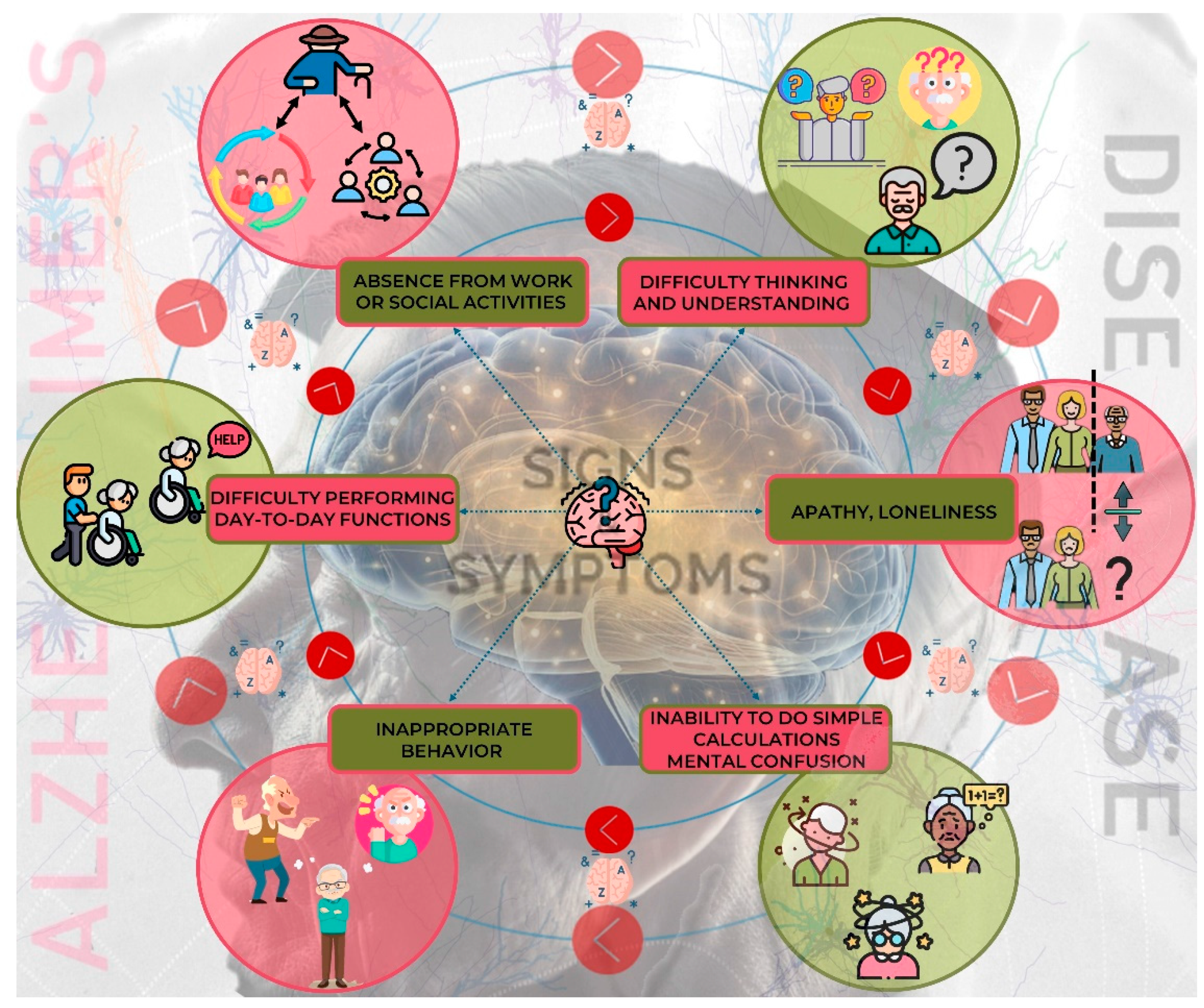
Figure 3.
Gingko biloba tree, its bioactive compounds, classification, and chemical structures.
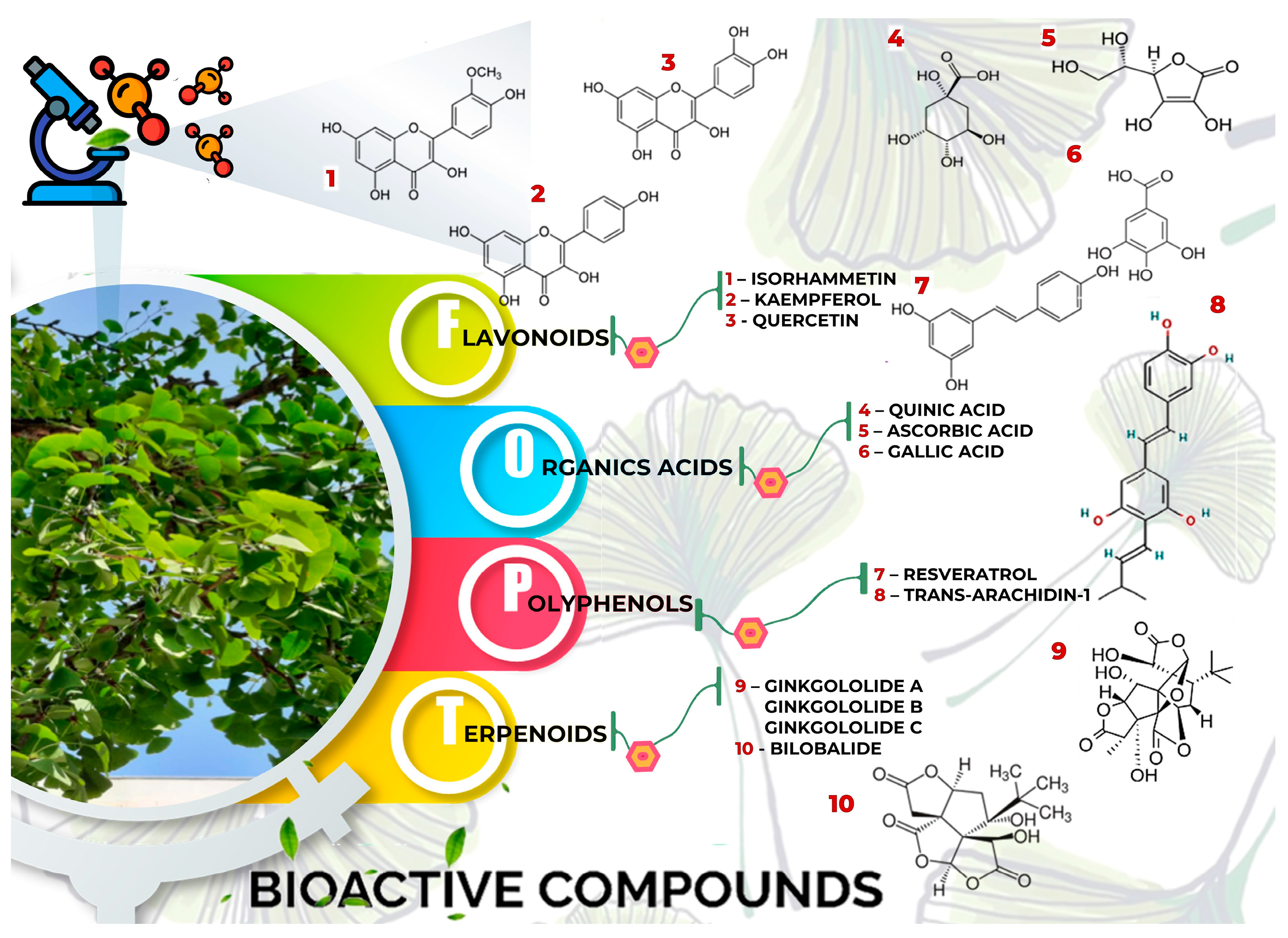
Figure 4.
General mechanisms of damage in Alzheimer's Disease (AD) and Ginkgo biloba. Gingko biloba and its extracts can protective roles against AD and can interfere with the formation of βA plaques. Furthermore, this plant can reduce inflammatory processes by down-regulating the release of pro-inflammatory cytokines such as IL-1, IL-6, TNF- α. Moreover, it can reduce ROS generation, oxidative stress, and apoptosis. This scenario offers prevention of AD. ↑ – increase; ↓ –decrease; APP – amyloid precursor protein; βA – β-amyloid; GB – Ginkgo biloba; IL – interleukin; NF-KB – nuclear factor KB; ROS – reactive oxygen species; TNF – α: Tumor Necrosis Factor- α.
Figure 4.
General mechanisms of damage in Alzheimer's Disease (AD) and Ginkgo biloba. Gingko biloba and its extracts can protective roles against AD and can interfere with the formation of βA plaques. Furthermore, this plant can reduce inflammatory processes by down-regulating the release of pro-inflammatory cytokines such as IL-1, IL-6, TNF- α. Moreover, it can reduce ROS generation, oxidative stress, and apoptosis. This scenario offers prevention of AD. ↑ – increase; ↓ –decrease; APP – amyloid precursor protein; βA – β-amyloid; GB – Ginkgo biloba; IL – interleukin; NF-KB – nuclear factor KB; ROS – reactive oxygen species; TNF – α: Tumor Necrosis Factor- α.
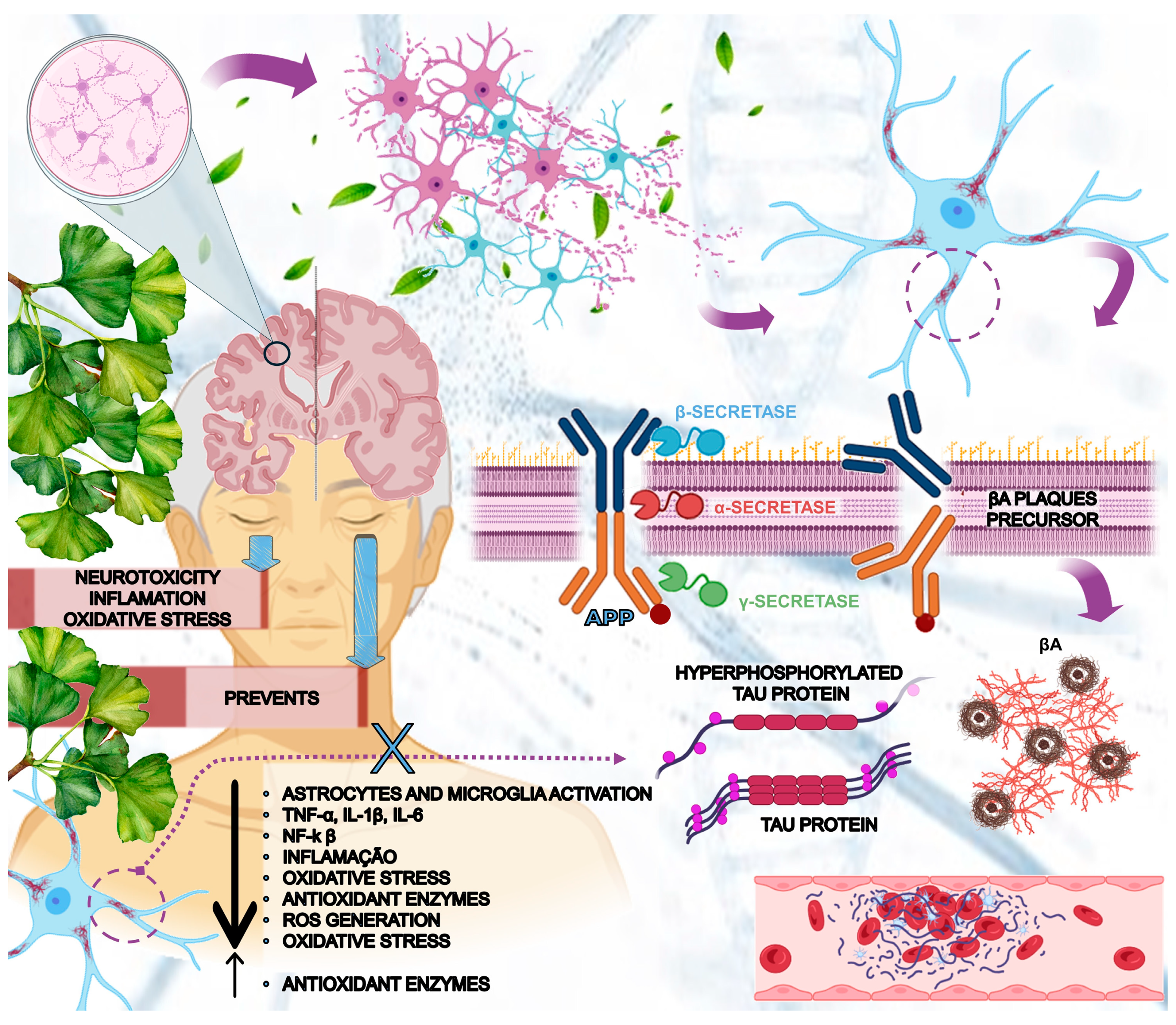
Table 1.
Effects of Ginkgo biloba in Alzheimer's Disease and dementia.
| Reference | Model/Country | Population | Intervention/Comparison | Outcomes | Adverse events |
|---|---|---|---|---|---|
| [34] | Randomized, double-blind, placebo-controlled study design in an outpatient setting/Egypt. | 60 individuals complaining of memory impairment or forgetfulness and satisfying the clinical criteria for mild cognitive impairment, 27 ♂, 33 ♀, 50-80y. | The subjects were divided into 2 groups: G1 received one Memo capsule (combination of 750 mg of lyophilized royal jelly with standardized extracts of GB 120mg) 1x/d/4 weeks, and G2 received placebo. | Only the group treated with MEMO exhibited a statistically significant improvement in MMSE score after 4 weeks. The mean change in MMSE was +2.067 versus +0.133, respectively. | Neither group reported any serious AE (mild nausea, transient headache, and palpitation). |
| [35] | Randomized, parallel-group, double-blind, placebo-controlled GuidAge clinical trial/France. | 2820 patients who spontaneously reported memory complaints, 940 ♂, 1880 ♀, 70y or older. | Patients were divided into 2 groups: G1 received 120 mg standardized GB extract (EGb761) 2x/d, and G2 received placebo. | The study did not provide evidence for the protective effect of GB extract on incidence of AD. | Both groups presented serious events such as death, stroke, bleeding, or cardiac disorders. |
| [36] | Randomized, double-blind clinical trial/Iran. | 56 patients with primary degenerative dementia of the AD type, 51 completed the study, 23 ♂, 28 ♀, 50-75y. | Patients were divided into G1 received GB (120 mg) 1x/d/24w, and G2 received rivastigmine (4.5 mg) 1x/d/24w. | This trial establishes GB efficacy and tolerability in Alzheimer's dementia; however, it is not to the same level as rivastigmine. | Group 2: one adverse event was observed but not specified. |
| [37] |
Randomized, controlled, double- blind, multi-center trial/Ukraine. | 333 patients diagnosed with mild to moderate dementia AD, 113 ♂, 220 ♀, 50y or more; and 71 patients diagnosed with VaD, 19 ♂, 52 ♀, 50y or more. |
Patients were divided into G1, received 240mg of GB extract EGb 761®, 1x/d/24w and G2, which received placebo. Patients diagnosed with VaD were divided into two groups: G1 received 240 mg of GB extract EGb 761, 1x/d/24w, and G2 received placebo. |
EGb 761® improved cognitive function, neuropsychiatric symptoms, and functional abilities in both types of dementia. Significant differences were observed in SKT and NPI scores, and in most secondary outcomes, with no notable variations between AD and VaD subgroups. | Both groups presented headache, respiratory tract infection, increased blood pressure, and dizziness. |
| [38] | Multi-center, double-blind, randomized, placebo-controlled/Republic of Belarus, Republic of Moldova, and Russian Federation. |
410 patients suffering from mild to moderate AD or VaD, of those 402 were counted into consideration, 123♂, 279♀, 50y or more. |
Patients were randomized into 2 groups: G1 received GB (240 mg) 1x/d/24w and G2 received placebo. | After the interaction, G1 showed that EGb 761® 1xd at 240mg effectively treats dementia, significantly improving cognitive performance and neuropsychiatric symptoms in patients (p < 0.001). | G1 and G2: headache: dizziness, respirator tract infection, hypertension: somnolence; upper abdominal pain., |
| [39] | Multi-center, double-blind, randomized, parallel-group clinical trial/Ukraine. | 410 individuals with: probable AD (NINCDS-ADRDA criteria); possible AD with CVD (NINDS-AIREN criteria); or probable VaD (NINDS- AIREN criteria); (symptoms of dementia had to be present for at least 6 m), 132♂, 272♀, 50y or older. | Population was divided into 2 groups: G1 received a once-daily tablet with 240 mg of EGb 761®; G2 received placebo. A screening period up to 4 weeks was necessary and was followed by a 24-week treatment period. | EGb 761® was better than placebo for improving SKT and NPI total score (placebo group worsened in SKT, and did not show alteration on the NPI total score). | G1 and G2 showed similar side effect rates (headache, respiratory tract infection, hypertension, dizziness). |
| [40] | Open, uncontrolled, clinical trial/Switzerland. | 59 patients (DemTect score > 12, no obvious symptoms of dementia, and with the presence of at least two of the following symptoms: forgetfulness, impaired concentration, or impaired memory), 15 ♂, 44 ♀, 60y or older. | All patients received 90mg of fresh plant GB extract 2x/d/6w. | At the final visit, SF-12 mental score significantly increased from 48.3 ± 10.1 to 51.3 ± 7.9, but SF-12 body score (44.5 ± 9.2 to 45.3 ± 8.1) and DemTect score (15.9 ± 2.0 to 16.0 ± 2.3) did not change significantly. About half of the patients experienced memory and concentration improvement and fewer forgetfulness symptoms. | Twenty-seven patients reported 39 AE, which were not specified. |
| [41] | Randomized, double-blind exploratory trial/Bulgaria. | 96 patients meeting the NINCDS-ADRDA criteria for probable AD, scored below 36 on the TE4D, below 6 on the CDT, between 9 and 23 on the SKT, and at least 5 on the 12-item NPI, 29 ♂, 65 ♀, 50y or older. | Patients were divided in 3 groups: G1 received EGb 761 120 mg 2x/d; G2 received donepezil at a daily dose of 5 mg during the first 4 weeks and 10 mg for the remaining 18 weeks; G3 received both drugs at recommended doses. It was established a 22-week-treatment period. | During treatment, patients of 3 groups showed improvements over baseline values in all tests and rating scales. No statistically significant or clinically relevant differences could be detected between treatments. | 26 AE were documented for 10 patients treated with EGb 761, 51 for 24 patients taking donepezil, and 29 for 18 patients receiving combined treatment. The most frequent: headache, insomnia, diarrhea, and fatigue. |
| [42] | Randomized, double-blind, placebo-controlled clinical trial/USA. | 3069 with normal cognition (n = 2587) or MCI (n = 482) (impaired at or below the 10th percentile of Cardiovascular Health Study normative data, stratified by age and education, on at least 2 of 10 selected neuropsychological test scores from each cognitive domain, + CDR global score of 0.5), 1651♂, 1418 ♀, 75y or older. | Patients were randomized into 2 groups: G1 received GB extract (120 mg) 2x/d, and G2 received placebo. There was a median follow-up of 6.1 years). | 523 individuals with dementia (246 placebo, 277 GB); 92% classified as possible/probable AD or AD with brain vascular disease evidence. The rate of total dementia was 3.3 per 100 person-years in the GB group and 2.9 in placebo. GB had no effect on dementia or AD incidence in older people with normal cognition or MCI. | The AE profiles for the groups were similar, and there were no statistically significant differences in the rate of serious AE (death, coronary heart disease, stroke, bleeding). |
| [43] | A randomized, placebo- controlled, double-blind clinical trial/Ukraine. | 400 patients with probable AD, possible AD with CVD or probable VaD, all of them with mild to moderate dementia as evidenced by a total score from 9 to 23 (both inclusive) on the SKT test battery, 110 ♂, 285 ♀, 50y or older. | Patients were allocated to receive either two tablets of EGb 761® 120 mg or placebo per day for 22 weeks, being preceded by a medication-free screening period of up to 4 weeks. |
The patients treated with EGb 761® improved cognitive test performance regarding neuropsychiatric symptoms and activities of daily living; placebo deteriorated slightly on most of the outcome measures or remained unchanged, at best. | 166 patients randomized to EGb 761® reported 302 AE, and 178 patients treated with placebo reported 81 AE (headache, angina pectoris, dizziness, back pain). |
| [44] |
Randomized, placebo-controlled, double-blind study/Italy. | 76 patients with dementia of the Alzheimer type, 35 ♂, 41 ♀, aged 50-80y. | Patients were randomized into 3 groups: G1 received GB 160 mg daily dose, G2 received donepezil 5 mg daily dose, G3 was given placebo for 24 weeks. | Compared with the donepezil group, attention, memory, and cognitive performance (SKT test) showed a comparable important improvement. | The frequency of AE was very low (upper respiratory tract infection, dizziness, tinnitus, nausea). |
| [45] | Randomized, placebo-controlled, double-blind, parallel-group, multicenter trial/USA. |
513 outpatients with uncomplicated dementia of the AD type scoring 10 to 24 on the MMSE and less than 4 on the modified HIS, without other serious health problems and not using continuous treatment to any psychoactive drug, 243 ♂, 270 ♀, 60y or older. | Patients were divided into 3 groups: G1 received placebo, G2 received 120 mg of EGb 761® per day (or twice-daily dose of 60 mg), and G3 received 240 mg of EGb 761® per day (or twice-daily dose of 120 mg). They were accompanied for 26 weeks. | No differences between the treatment groups regarding cognitive endpoint. Placebo group did not worsen notably from baseline. At the same time, a similar slight decline was found for both actively treated groups. | The frequency of AE and serious AE was very low (upper respiratory tract infection, dizziness, tinnitus, nausea). |
| [46] | Randomized, double-blind, placebo-controlled, parallel-group, multicenter trial/ Netherlands. | 214 participants with the diagnosis of Dementia (AD or VaD) or age-associated memory impairment (AAMI). 19 ♂, 104 ♀, 50y or older. | The subjects were randomly allocated to one of 3 treatments: G1: EGb 761® 240mg/d, G2: EGb 761® 160mg/d, and G3 placebo. After the 12-week treatment, the subjects were randomly separated in a second 12-week treatment period to continue their GB treatment or placebo. | No benefit of GB was observed. Small differences regarding SKT and CGI were found in GB group (no significant or clinically meaningful). |
35 AE were registered (Nausea, constipation, diarrhea, hospital entrance, and death) |
| [47] | Multi-center, double-blind, randomized, parallel-group, placebo-controlled trial/US. | 309 patients with a diagnosis of uncomplicated AD or multi-infarct dementia (ICD-10 and DSM-III-R criteria), 143 ♂, 166 ♀, 45y or older. | Patients were randomly allocated to either G1 (that received EGb 40 mg 3x/d) or G2 (placebo) for 52 weeks following a 2-week, single-blind, placebo run-in period. | In comparison to the base-line values, placebo showed significant worsening in all domains of assessment; EGb slightly improved cognitive assessment and the daily living and social behavior. | Nausea, constipation, and diarrhea in both groups |
| [48] | Randomized, double-blind, placebo-controlled, parallel-group, multicenter trial/Netherlands. |
214 patients with a mild or moderate stage of dementia (as assessed by the results of SIDAM interview and by a score of 8 - 23 on the SKT), 34 ♂, 180 ♀, 50y or older. | Patients were divided into 3 groups after a 3-week run-in period on placebo: G1 received EGb 761 120 mg 2x/d; G2 received twice-daily doses of EGb 761 80 mg; G3 continued receiving placebo. Outcomes were evaluated after 12 and 24 weeks of intervention. | In general, any remarkable shift in score on most of the outcome parameters during the intervention, either in the GB group or in the placebo | Dizziness, nervousness, and headache were the most common symptoms. |
Abbreviations: AD: Alzheimer's Disease; ADRDA: Alzheimer's Disease and Related Disorders Association; AE: Adverse events; AIREN: Association Internationale pour la Recherche et l'Enseignement en Neurosciences; CDT: Clocking-Drawing Test; CDR: Clinical Dementia Rating; CGI: Clinical Global Impression; CVD: Cardiovascular Disease; DemTect: a brief screening test for dementia comprising five short subtests; DSM-III-R: Diagnostic and Statistical Manual of Mental Disorders; GB: Gingko biloba; HIS: Hachinski Ischemic Score; ICD-10: International Classification of Diseases; MCI: Mild Cognitive Impairment; MEMO: combination of 750 mg of lyophilized royal jelly with standardized extracts of GB 120 mg; MMSE: Mini-Mental State Examination; NAA: Nuremberg Gerontopsychological Rating Scale for Activities of Daily Living; NBACE: Neuropsychological Battery of Fundació ACE; NINCDS: National Institute of Neurological and Communicative Disorders and Stroke; NINDS: National Institute of Neurological Disorders and Stroke; NPI: Neuropsychiatric Inventory; SF-12: 12-item Short Form Survey; SIDAM: Structured Interview For The Diagnosis of Dementia of the Alzheimer Type; SKT: Short Cognitive Performance Test; TE4D: Test For The Early Detection of Dementia With Discrimination from Depression; VaD: Vascular Dementia.
Table 2.
Risk of bias assessment included in this review.
| Study | Question focus | Appropriate randomization | Allocation blinding | Double-blind | Losses (<20%) |
Prognostics or demographic Characteristics |
Outcomes | Intention to treat analysis | Sample calculation | Adequate follow-up |
|---|---|---|---|---|---|---|---|---|---|---|
| [34] | Yes | Yes | Yes | Yes | Yes | Yes | Yes | NR | Yes | Yes |
| [35] | Yes | Yes | Yes | Yes | Yes | Yes | Yes | No | Yes | Yes |
| [36] | Yes | NR | Yes | Yes | Yes | Yes | Yes | No | NR | Yes |
| [37] | Yes | Yes | Yes | Yes | Yes | Yes | Yes | Yes | Yes | Yes |
| [38] | Yes | Yes | Yes | Yes | Yes | Yes | Yes | Yes | Yes | Yes |
| [39] | Yes | Yes | Yes | Yes | Yes | Yes | Yes | Yes | Yes | Yes |
| [40] | Yes | No | No | No | Yes | Yes | Yes | NR | NR | Yes |
| [41] | Yes | Yes | Yes | Yes | Yes | Yes | Yes | NR | NR | Yes |
| [42] | Yes | Yes | Yes | Yes | Yes | Yes | Yes | Yes | Yes | Yes |
| [43] | Yes | Yes | Yes | Yes | Yes | Yes | Yes | Yes | Yes | Yes |
| [44] | Yes | Yes | Yes | Yes | Yes | Yes | Yes | NR | NR | Yes |
| [45] | Yes | Yes | Yes | Yes | No | Yes | Yes | Yes | Yes | Yes |
| [46] | Yes | Yes | Yes | Yes | Yes | Yes | Yes | Yes | Yes | Yes |
| [47] | Yes | NR | NR | Yes | No | Yes | Yes | Yes | NR | Yes |
| [48] | Yes | Yes | Yes | Yes | Yes | Yes | Yes | Yes | Yes | Yes |
Abbreviations: NR: not reported.
Table 3.
Main bioactive compounds found in Ginkgo biloba.
| Bioactive compounds | Molecular structures | Part of the plant | Health effects | References |
|---|---|---|---|---|
| Bilobalide |  |
Leaves and bark. | Anti-inflammatory, antioxidant, anti-adipogenesis, pro-autophagy, and microcirculation-improving properties. | [59,60,61] |
| Ginkgolide A | 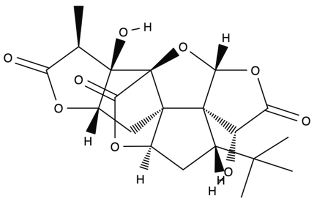 |
Leaves mostly, root and bark. |
Anti-inflammatory, antioxidant, anxiolytic-like, anti-atherosclerosis, anti-thrombosis, neuroprotective, and hepatoprotective. | [62,63,64] |
| Ginkgolide B |  |
Leaves mostly, root and bark. | Anti-inflammatory, antioxidant, antiplatelet aggregation, and anti-shock. | [65,66,67] |
| Ginkgolide C | 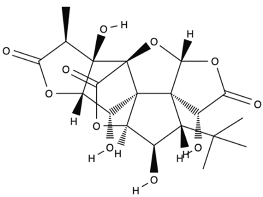 |
Leaves mostly, root and bark. | Anti-inflammatory, antioxidant, anti-cancer, and anti-adipogenesis. | [68,69] |
| Isorhamnetin | 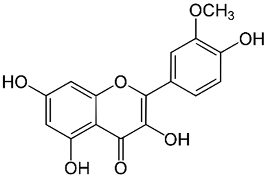 |
Leaves | Anti-inflammatory, antioxidant, anti-obesity, anti-tumor, neuroprotective, cardioprotective, and organ protection. | [70,71,72] |
| Kaempferol | 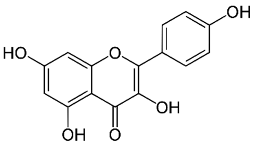 |
Leaves. |
Anti-inflammatoy, antioxidant, anti-cancer, cardioprotective, neuroprotective, and anti-cancer. | [73,74] |
| Luteolin | 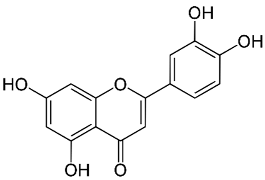 |
Leaves | Anti-inflammatory, antioxidant, anticancer, neuroprotective | [35,75,76,77,78] |
| Quercetin | 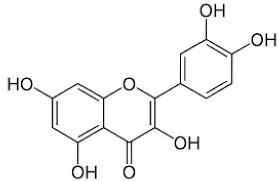 |
Leaves | Anti-inflammator, antioxidant, reduce degradation of serotonin by monoamine oxidases, anticancer |
[75,79,80,81,82,83,84] |
| Resveratrol | 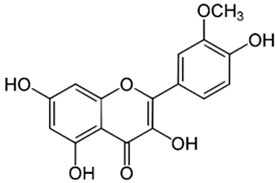 |
Oil, skin, roots, and leaves. | Anti-inflammatory, antioxidant, anti-obesity, antidiabetic, anti-hypertension, neuroprotective, cardioprotective, and anti-cancer. | [85,86,87,88] |
| Trans-arachidin-1 | 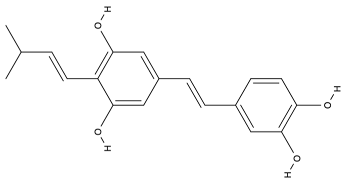 |
Oil, skin, roots, and leaves. | Anti-inflammatory, antioxidant, cardioprotective, and anti-cancer. | [89,90,91,92] |
Disclaimer/Publisher’s Note: The statements, opinions and data contained in all publications are solely those of the individual author(s) and contributor(s) and not of MDPI and/or the editor(s). MDPI and/or the editor(s) disclaim responsibility for any injury to people or property resulting from any ideas, methods, instructions or products referred to in the content. |
© 2024 by the authors. Licensee MDPI, Basel, Switzerland. This article is an open access article distributed under the terms and conditions of the Creative Commons Attribution (CC BY) license (https://creativecommons.org/licenses/by/4.0/).
Copyright: This open access article is published under a Creative Commons CC BY 4.0 license, which permit the free download, distribution, and reuse, provided that the author and preprint are cited in any reuse.
Alerts
MDPI Initiatives
Important Links
© 2025 MDPI (Basel, Switzerland) unless otherwise stated







